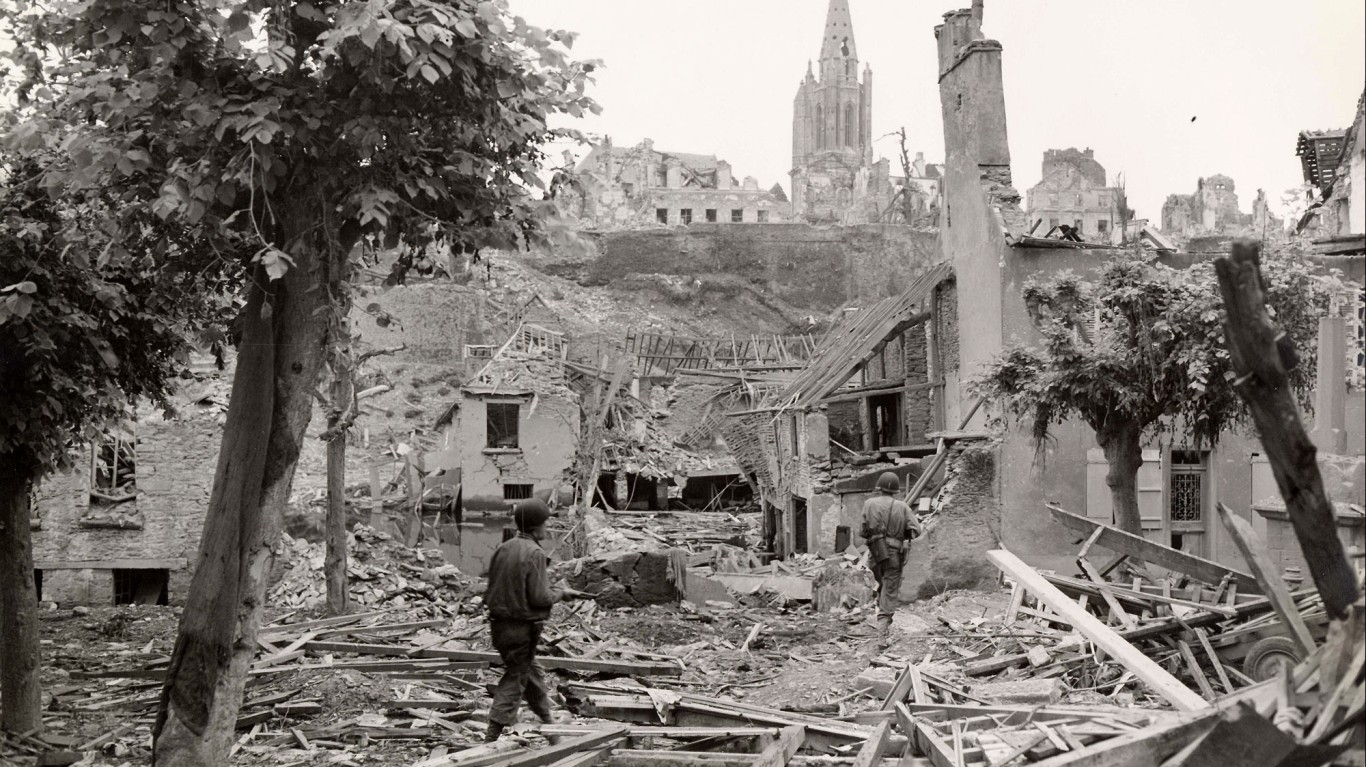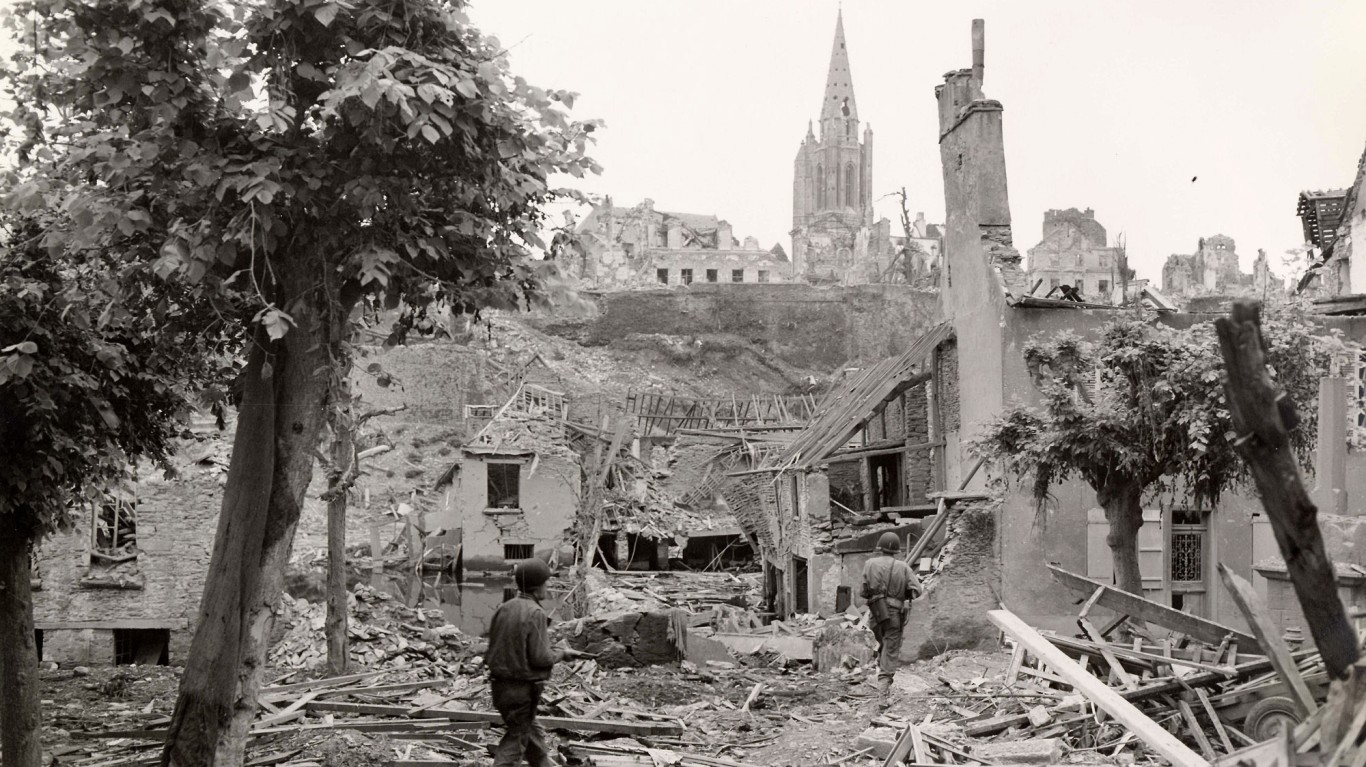
Throughout the course of World War II, many cities were reduced to ruins, whether by the Allies or the Axis Powers. Air raids and ground battles leveled cities, creating shocking hellscapes of the once thriving metropolises.
After the war, the reconstruction and healing process in these cities began. The destruction prompted conversations on war ethics, peacebuilding, and international relations that continue to this day.
To identify the cities destroyed by the United States during WWII, 24/7 Wall St. used a variety of historical sources to confirm the dates, locations, and affected area of the cities most devastated by the bombing campaigns of the United States and the other Allied nations. We considered cities where over 50% of the city was destroyed or that had significant reported casualties.
The bombing of Dresden, though not at the top of the list, is one of the most famous and controversial entries. The Allies bombing of the city in February 1945 virtually obliterated the thriving cultural center that held little military significance. Over a few days of relentless bombing, the Allies dropped thousands of tons of incendiary and explosive bombs, creating a firestorm that killed approximately 25,000 people and laid waste to a significant portion of the city. (Here are WWII bombings that involved the most planes.)
Perhaps the most famous bombings from this era were the atomic bombings of Hiroshima and Nagasaki by the United States in August 1945. Introducing the world to the horrifying power of nuclear weaponry, Hiroshima became the first target on Aug. 6, followed by Nagasaki on Aug. 9. The bombs, nicknamed “Little Boy” and “Fat Man,” caused unprecedented destruction, triggering ethical questions surrounding the use of nuclear weapons in war.
Noticeably, most of the attacks and bombings of Axis cities took place in either 1944 or 1945, towards the tail end of the war, when the Allied Forces had finally turned the tide in their favor in both the European and Pacific Theaters. D-Day took place on June 6, 1944, giving the Allies a stronger foothold in Europe that allowed for more operations in the continent.
In the Pacific Theater, the turning point for the U.S. campaign was at the Battle of Midway in June 1942, but it would take more time to cover the vast distance of the Pacific Ocean to stage attacks on the home islands of Japan. (These are the biggest american naval battles of WWII.)
Here is a look at the cities destroyed by the United States in World War II.
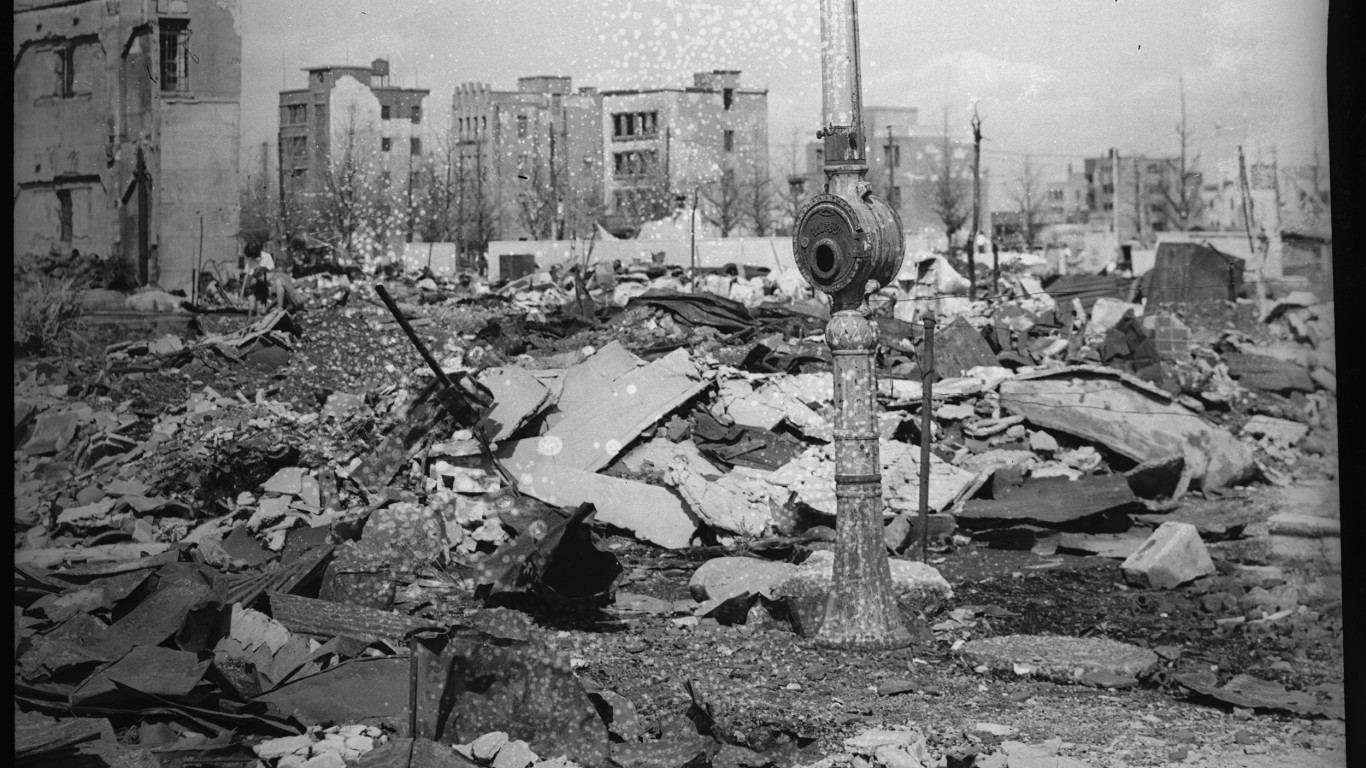
42. Tokyo, Japan
> Share of city destroyed: 51.0%
> Date of attack: March 9-10, 1945
> Casualties: 124,711
Japan’s capital, with a population of about the size of New York City’s at the time, was firebombed on March 9-10, 1945. More than half of the city was destroyed.
[in-text-ad]

41. Frankfurt, Germany
> Share of city destroyed: 52.0%
> Date of attack: March 26-29, 1945
> Casualties: 5,500
The bombing of Frankfurt am Main by the Allies — first the Royal Air Force and then the U.S. — killed about 5,500 residents and wiped out the largest medieval city center in Germany.
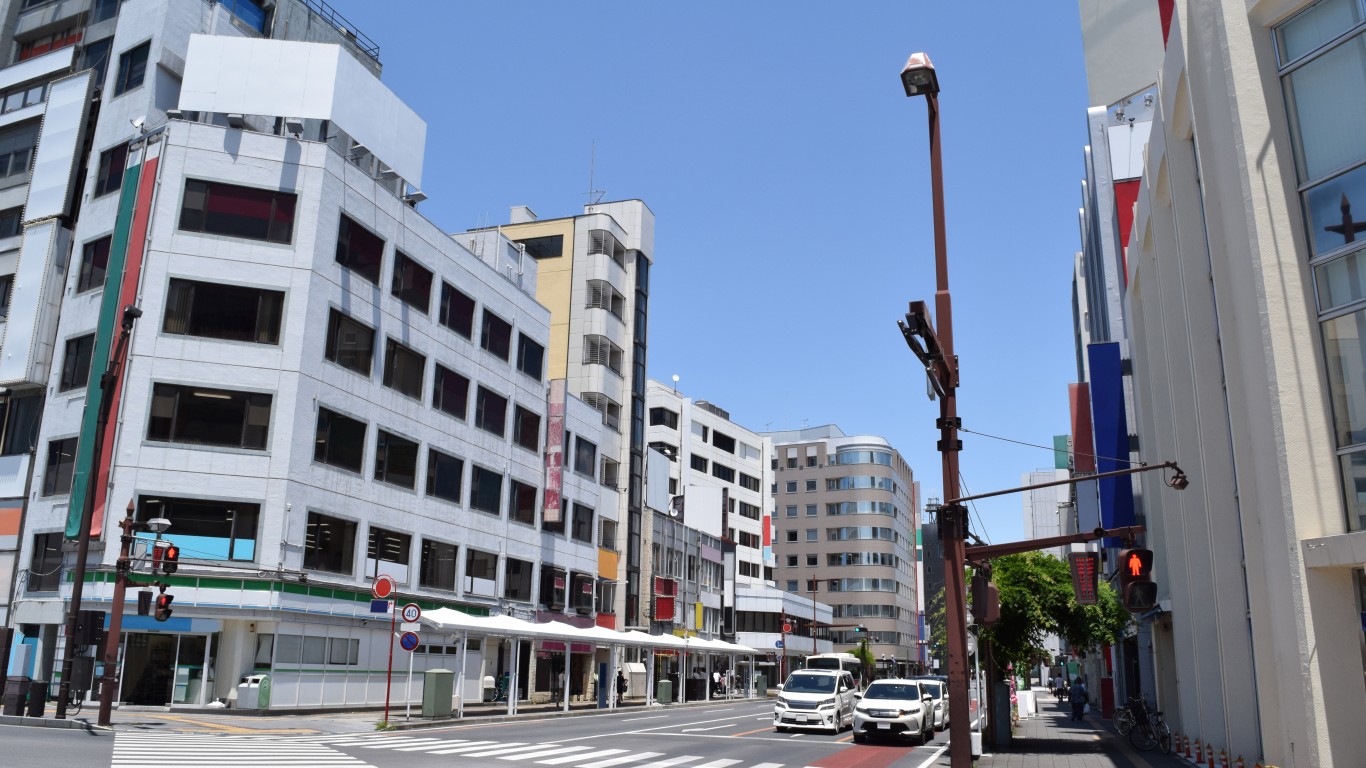
40. Kumagaya, Japan
> Share of city destroyed: 55.1%
> Date of attack: August 14, 1945
> Casualties: 266
Seventy-seven B-29s dropped incendiary bombs on the city where aircraft components were made and the Japanese Army’s air academy was located. As of the 1940 census, 45,000 people lived in Kumagaya.
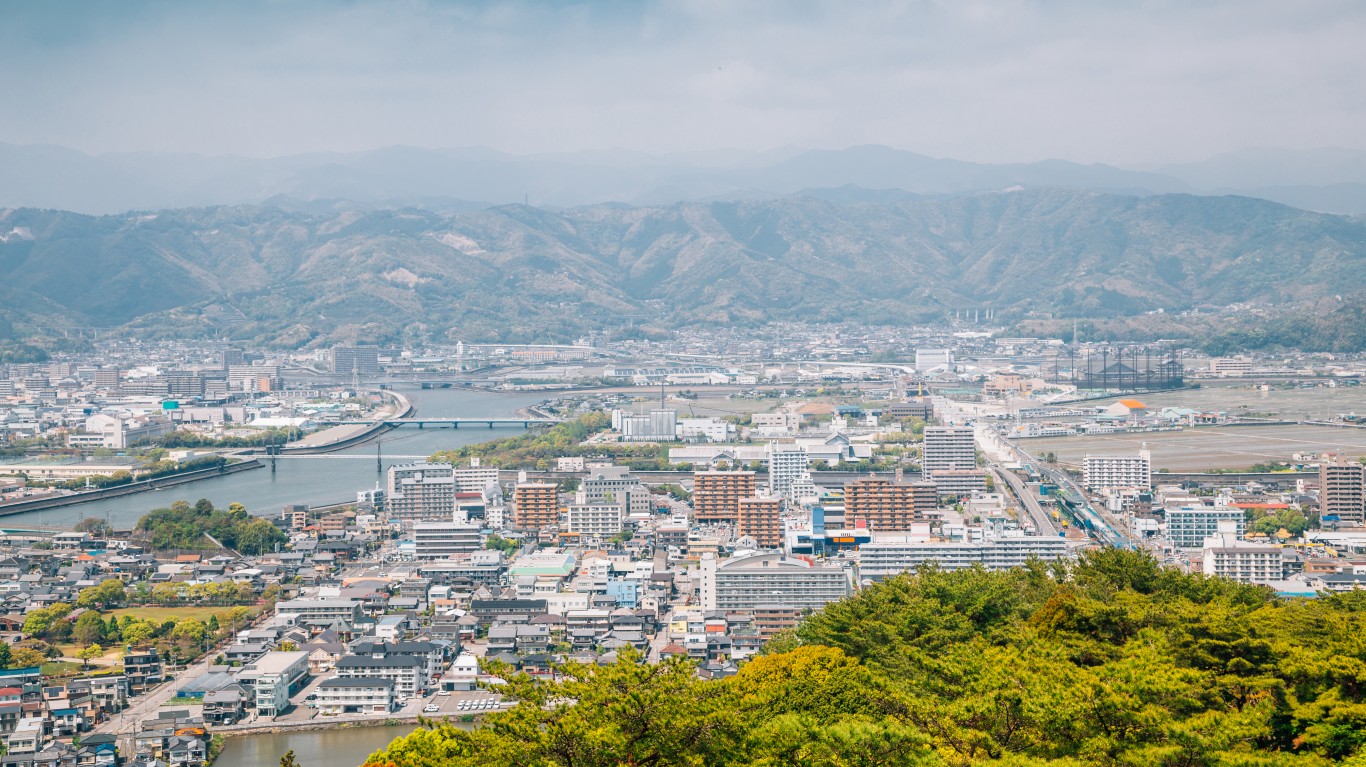
39. Kōchi, Japan
> Share of city destroyed: 55.2%
> Date of attack: July 3, 1945
> Casualties: N/A
This Japanese city on the island of Shikoku, roughly the size of Sacramento, was devastated by an American air raid in July 1945.
[in-text-ad-2]

38. Kobe, Japan
> Share of city destroyed: 55.7%
> Date of attack: March 16-17, 1945
> Casualties: 8,841
Kobe, about the size of Baltimore, was chosen for attack because it was the sixth largest city in Japan at the time, with a population of around a million. It also was Japan’s biggest port, with large shipbuilding and marine-engine manufacturing facilities. The city’s houses were mostly flimsy and highly flammable, so damage was extensive.
37. Ichinomiya, Japan
> Share of city destroyed: 56.3%
> Date of attack: July 12, 1945
> Casualties: N/A
Ichinomiya, on the eastern coast of Japan, is a city that was about the size of Springfield, Ohio, when it was bombed in July 1945 as part of the wider strategic bombing plan by the U.S.
[in-text-ad]
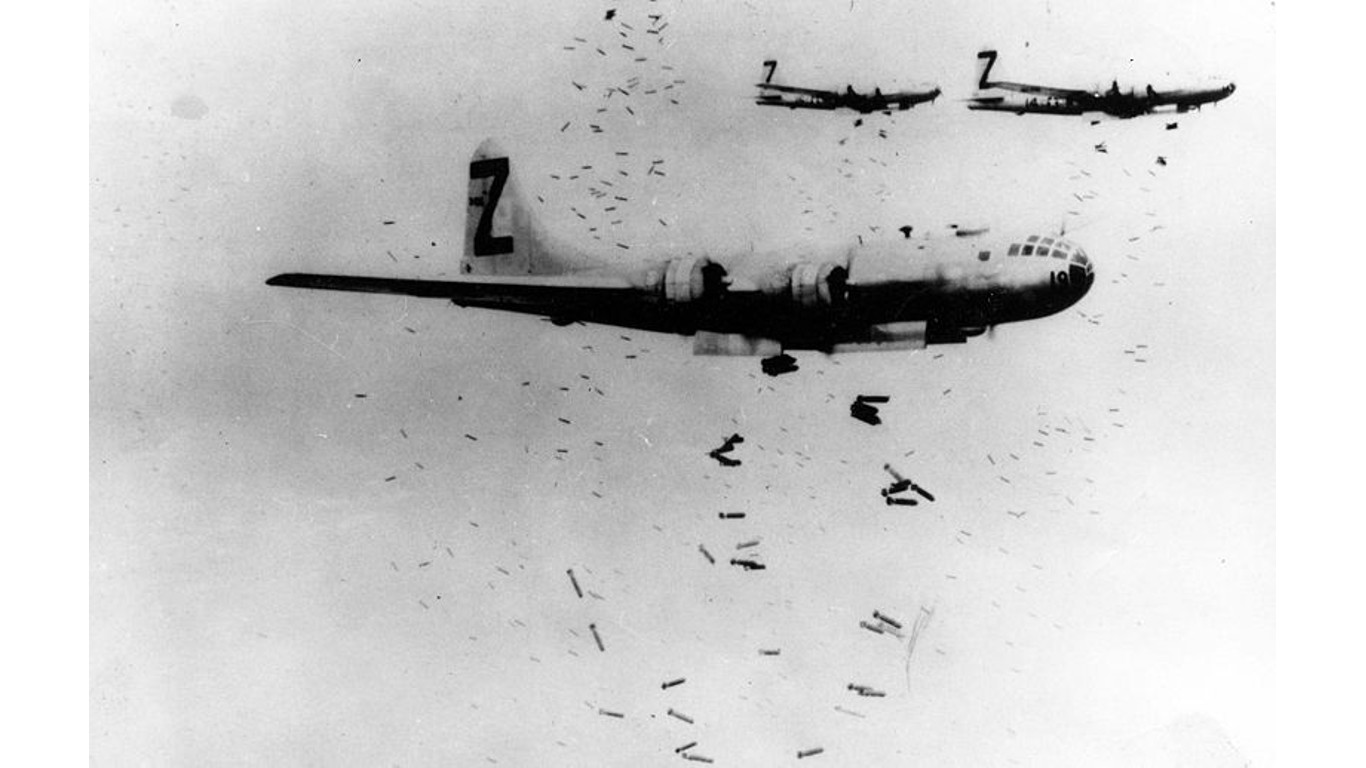
36. Isesaki, Japan
> Share of city destroyed: 56.7%
> Date of attack: August 14-15, 1945
> Casualties: N/A
Isesaki, a city with a population of more than 213,000 today, is located 59 miles from Tokyo, in the center of the country. It was attacked on Aug.14-15, 1945, five days after Nagasaki sustained the world’s second nuclear bomb strike.
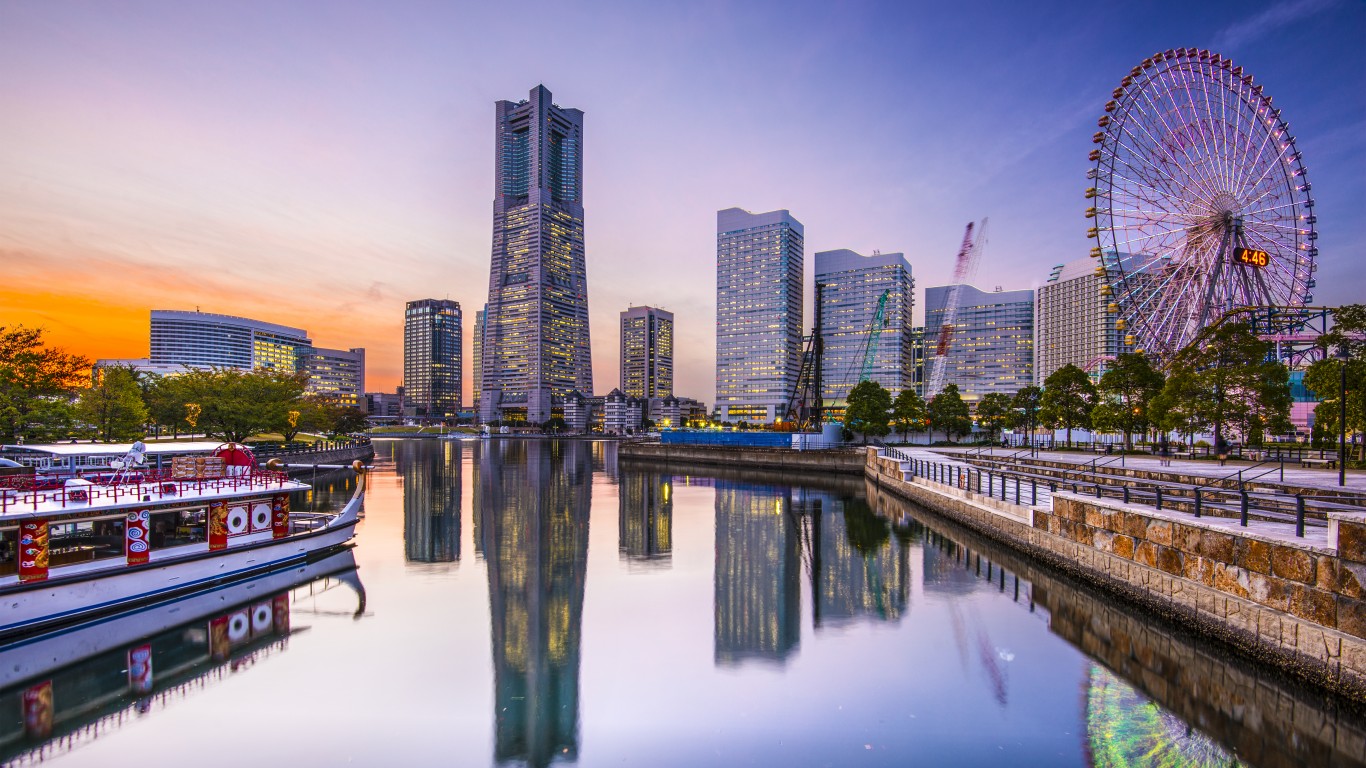
35. Yokohama, Japan
> Share of city destroyed: 58.0%
> Date of attack: May 29, 1945
> Casualties: 14,157
Yokohama, a city about the same size as Cleveland, was attacked with incendiary bombs dropped by 517 B-29s, burning out 6.9 square miles. The city had been attacked earlier by the U.S. on April 18, 1942, in the so-called Doolittle Raid, retaliating for the Japanese attack on Pearl Harbor.
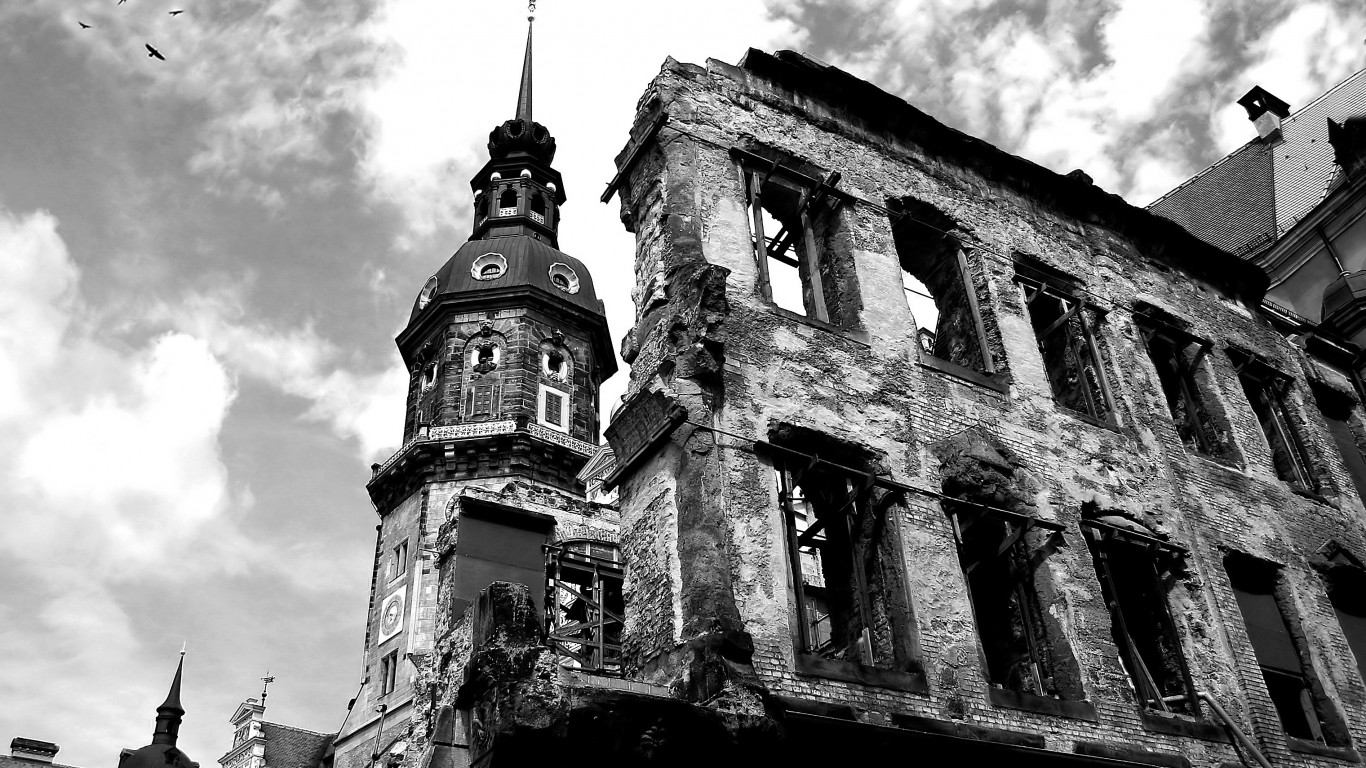
34. Dresden, Germany
> Share of city destroyed: 59.0%
> Date of attack: February 13-15, 1945
> Casualties: 25,000
This city in Saxony, famed for its medieval history and architecture and not considered vital to the German war effort, was severely damaged by U.S. planes in 1945. In four raids in mid-February, 772 heavy bombers of the Royal Air Force and 527 of the United States Army Air Forces dropped more than 3,900 tons of high-explosives and incendiary devices on the city. The bombing and the resulting firestorm destroyed more than 1,600 acres of the city’s center.
[in-text-ad-2]

33. Bremen, Germany
> Share of city destroyed: 60.0%
> Date of attack: May 1940 – April 22, 1945
> Casualties: 4,000
The German port city of Bremen was a frequent target of Allied bombing, attacked 173 times during the course of the war. The heaviest air raid hit the city the night of Aug. 18âÂÂ19, 1944. In 34 minutes, 274 aircraft dropped 1,120 tons of bombs on the western portion of the city, killing 1,059 people, destroying 8,248 residential buildings, and leaving 50,000 homeless.

32. Hamamatsu, Japan
> Share of city destroyed: 60.3%
> Date of attack: February 15, 1945
> Casualties: 150
Hamamatsu was a major transportation hub connecting Tokyo with Osaka, with a population of 166,346. It also was the site of armaments factories and a flight school for the Japanese Army Air Force, and was on the main flight route from Saipan to both Nagoya or Tokyo. A coastal city, it was both attacked by bombers and shelled by American and British battleships.
[in-text-ad]

31. Toyohashi, Japan
> Share of city destroyed: 61.9%
> Date of attack: June 19, 1945
> Casualties: 624
Toyohashi is located about halfway between Osaka and Tokyo, along the Pacific coastline in Aichi prefecture. Once known for silk making, it became a so-called military city in the early 20th century, manufacturing cannon and machine guns. The U.S. incendiary-bombed Toyohashi on the evening of June 19-20, 1945, killing 624 people.
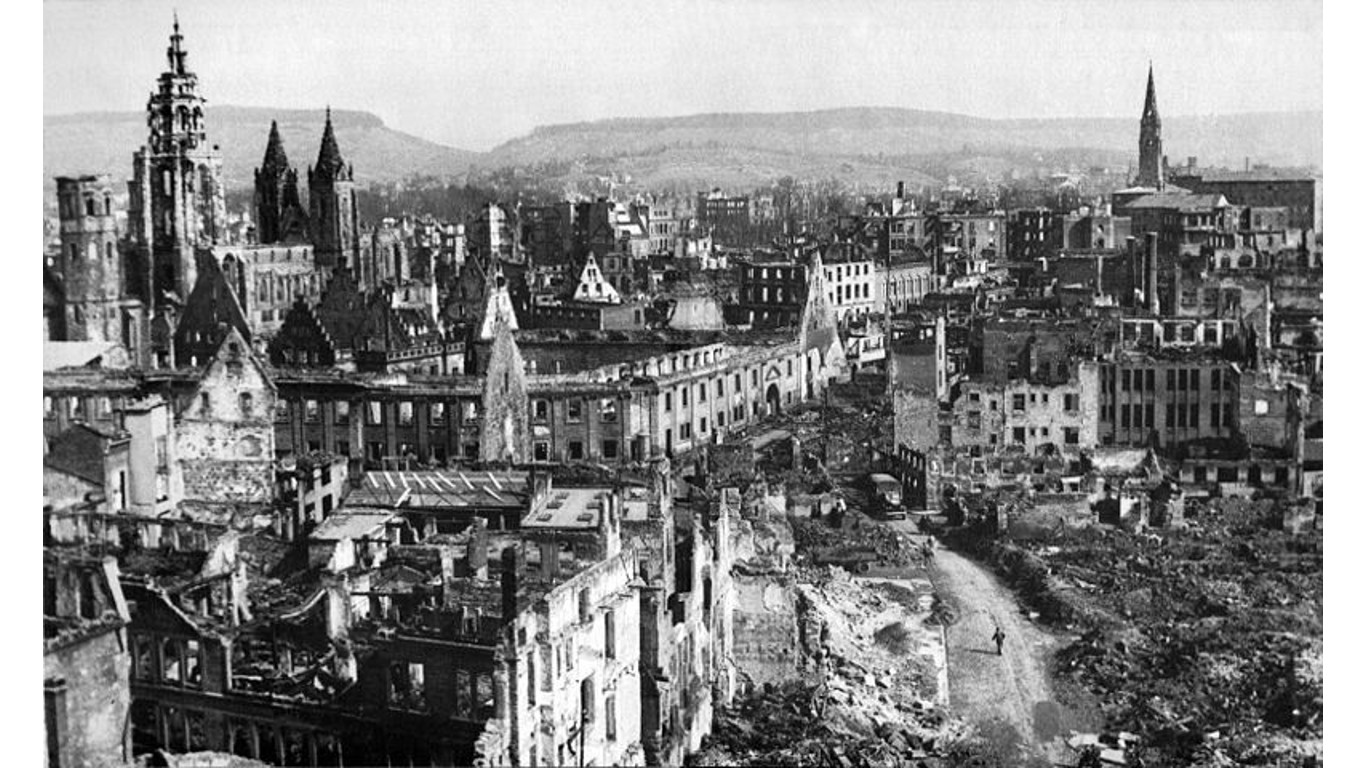
30. Heilbronn, Germany
> Share of city destroyed: 62.0%
> Date of attack: December 4, 1944
> Casualties: 7,000
Heilbronn, in southwestern Germany along the Neckar River, was attacked many times by the Allies. The most lethal attack occurred on Dec. 4, 1944. Between Dec. 27, 1944 and March 31, 1945, 13 air raids hit Heilbronn.
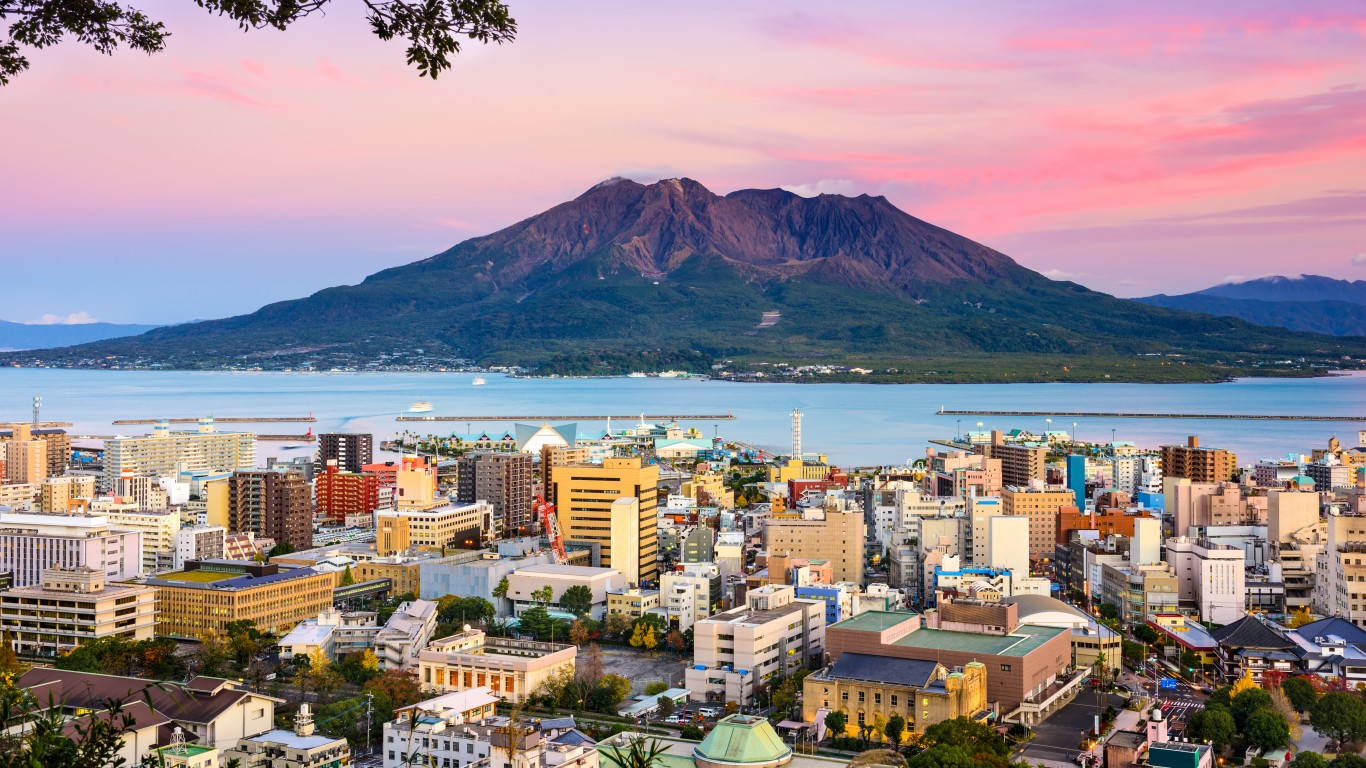
29. Kagoshima, Japan
> Share of city destroyed: 63.4%
> Date of attack: April 8 and 16, 1945
> Casualties: N/A
Kagoshima, located at the southwestern tip of the island of Kyushu, was targeted by the U.S. because of its expanded naval port as well as its position as a railway terminus.
[in-text-ad-2]
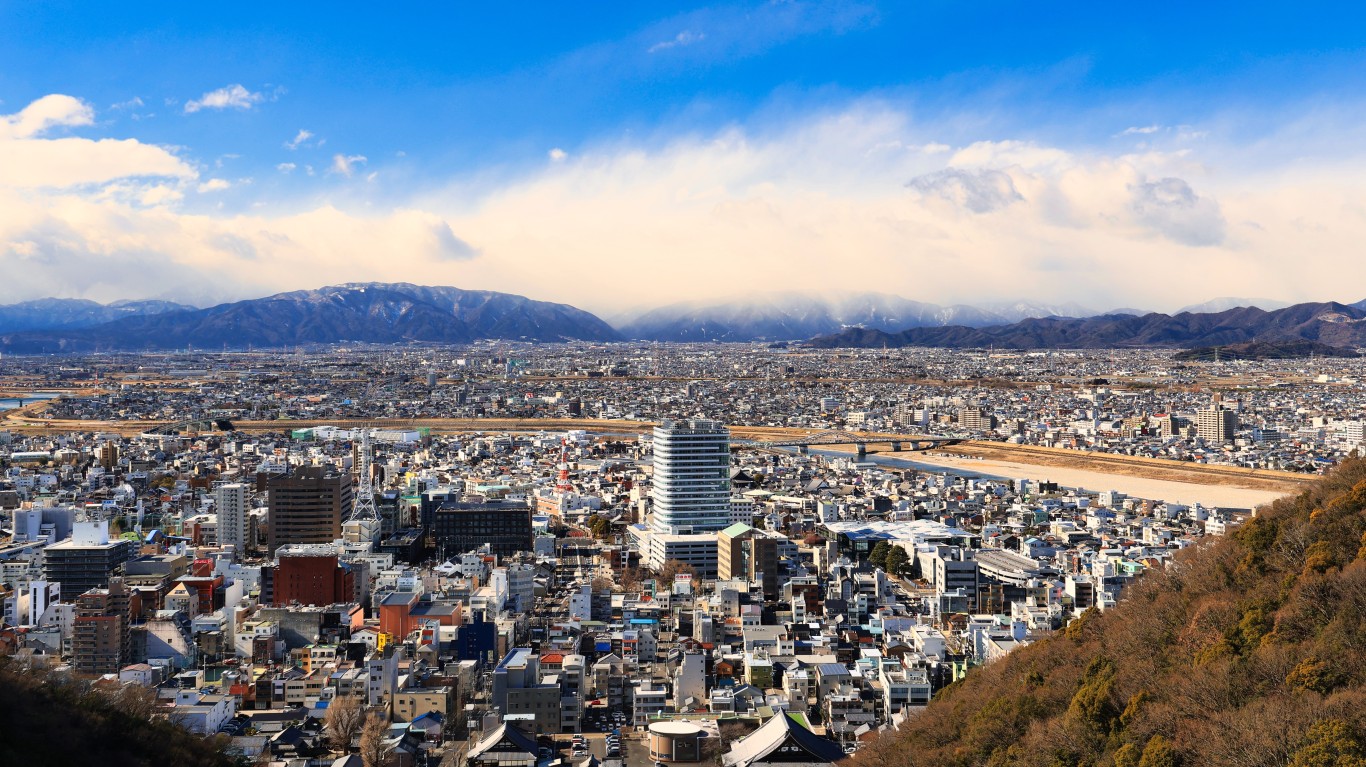
28. Gifu, Japan
> Share of city destroyed: 63.6%
> Date of attack: July 9, 1945
> Casualties: 818
On July 9, 1945, 131 American aircraft dropped 907 tons of firebombs on the central Japanese city of Gifu, igniting an inferno that torched a two-mile radius in the city center. More than 800 people died, 1,200 were injured, and 100,000 were left homeless.
27. Imabari, Japan
> Share of city destroyed: 63.9%
> Date of attack: August 5, 1945
> Casualties: N/A
Imabari, a shipbuilding center in southwestern Japan, had been attacked earlier in 1945 by Allied bombers before a lethal attack occurred on Aug. 5, 1945, the day before an atomic bomb fell on Hiroshima.
[in-text-ad]
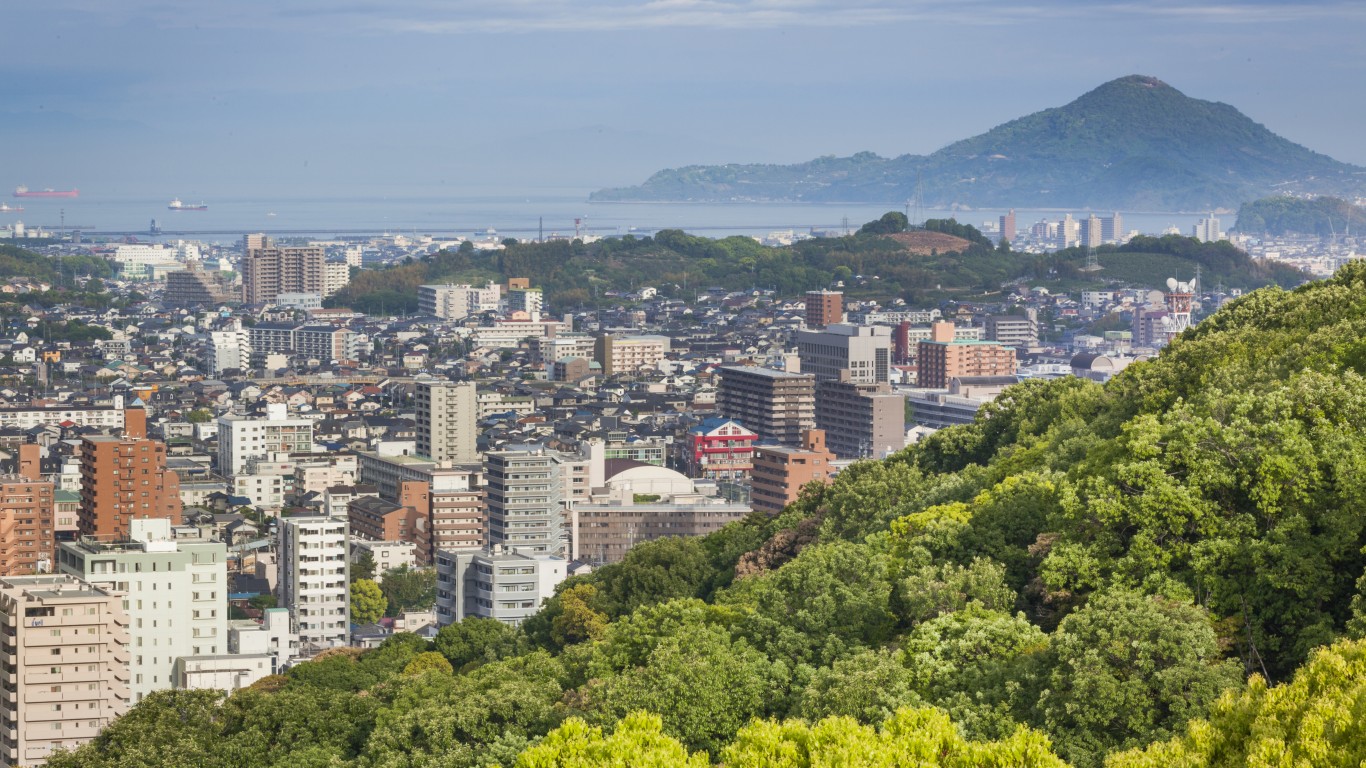
26. Matsuyama, Japan
> Share of city destroyed: 64.0%
> Date of attack: August 12, 1945
> Casualties: 251
Matsuyama, the largest city on the island of Shikoku, was attacked multiple times, including by a raid just days before Japan surrendered to the Allies.
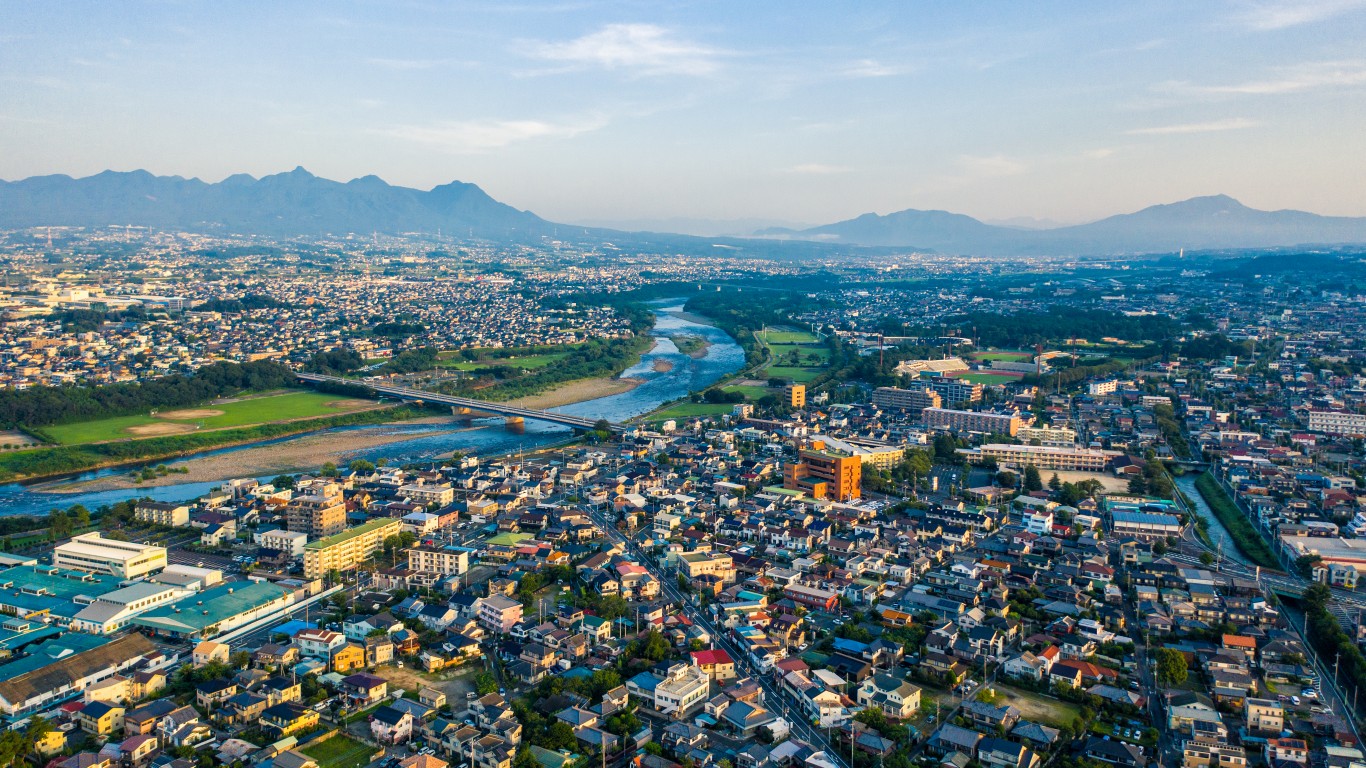
25. Maebashi, Japan
> Share of city destroyed: 64.2%
> Date of attack: August 5, 1945
> Casualties: N/A
A day before the U.S. ushered in the atomic age by dropping a nuclear bomb on Hiroshima, America continued with its conventional bombing strategy by attacking Maebashi. The city, in the center of Japan, was largely destroyed by Allied bombing during World War II, but it recovered and developed into an industrial and communications center after the war.
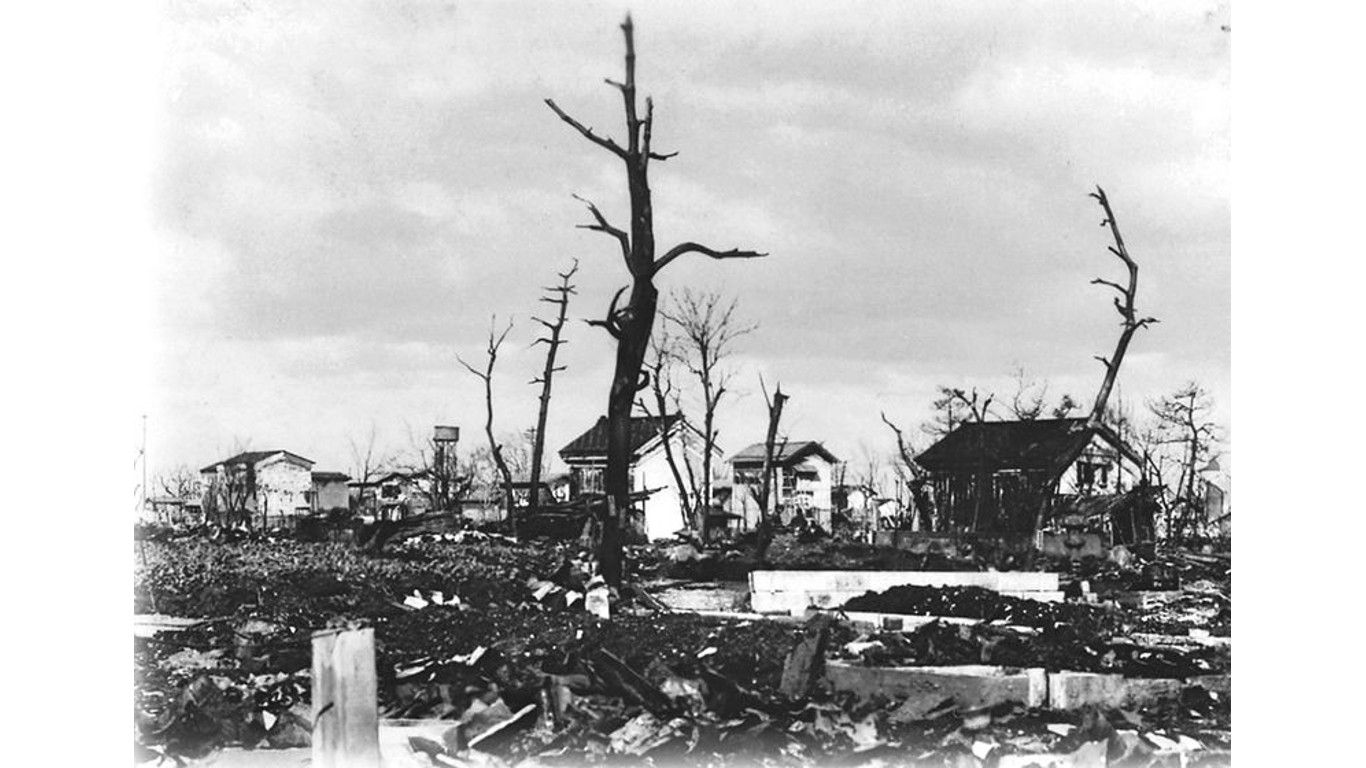
24. Nagaoka, Japan
> Share of city destroyed: 64.9%
> Date of attack: August 1, 1945
> Casualties: 1,486
Nagaoka was a commercial center and home to one of the laboratories of Japan’s Institute of Physical and Chemical Research. It also was the hometown of Japanese Admiral Isoroku Yamamoto, who planned the attack on Pearl Harbor. On Aug, 1, 1945, 125 B-29s struck the city with an estimated 163,000 incendiary bombs totaling 925 tons. The raid lasted for 1 hour and 40 minutes.
[in-text-ad-2]
23. Hachiōji, Japan
> Share of city destroyed: 65.0%
> Date of attack: February 9, 1945
> Casualties: N/A
Hachiōji is in the foothills of the Okutama Mountains, which surround it on three sides, about 25 miles west of Tokyo. It was heavily damaged in early February 1945, and attacked on other occasions during the war, but was rebuilt and grew as a Tokyo suburb.
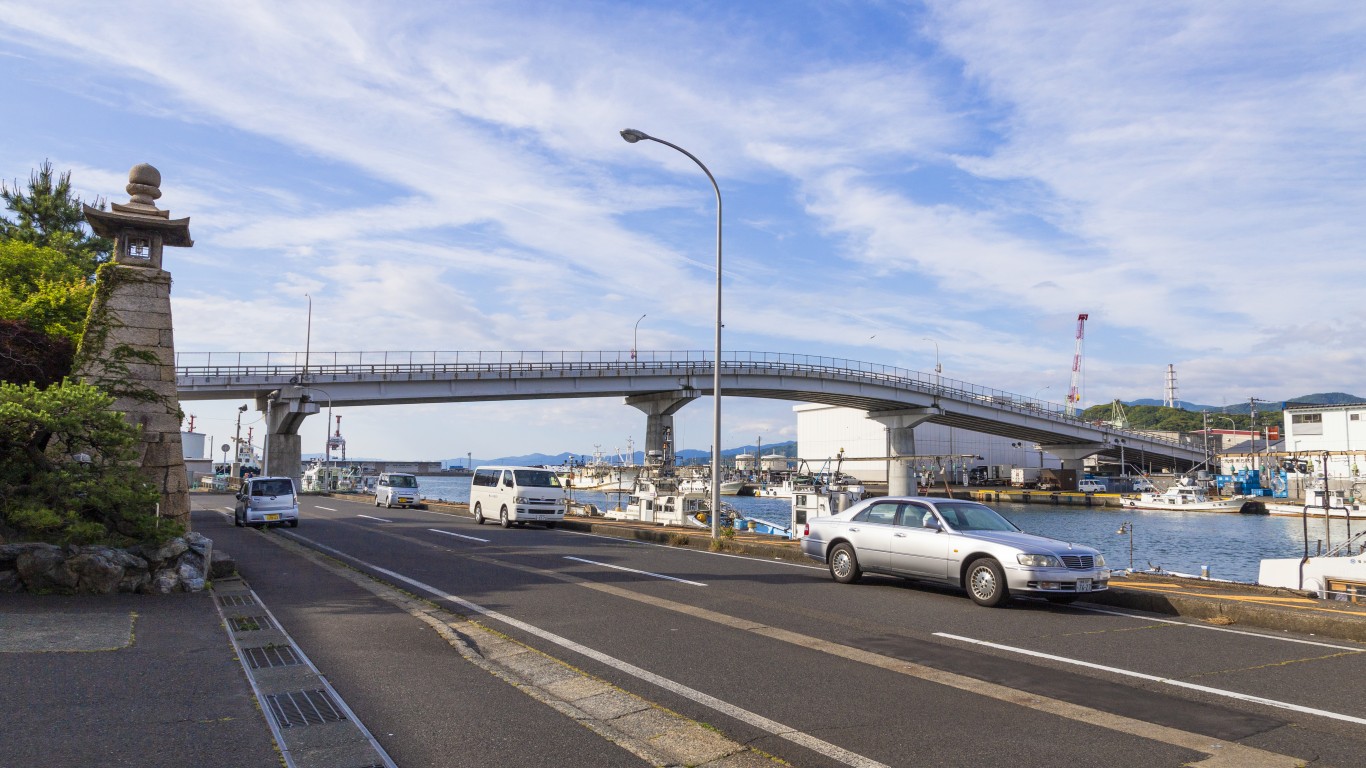
22. Tsuruga, Japan
> Share of city destroyed: 65.1%
> Date of attack: July 12, 1945
> Casualties: N/A
Tsuruga became the first city of the Sea of Japan coast to be targeted by air raids on the night of July 12, 1945. The city’s defenses were inadequate, and more than 65% of Tsuruga was razed by incendiary bombs.
[in-text-ad]
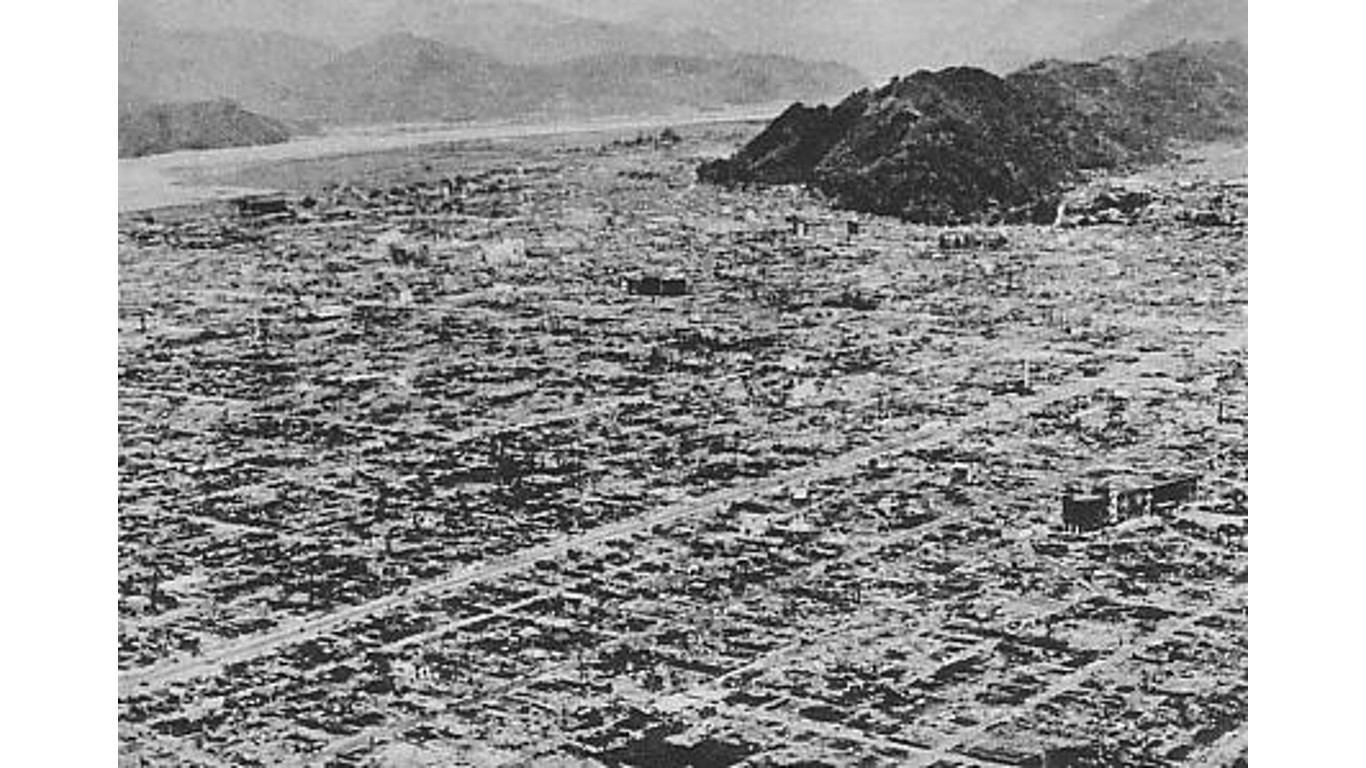
21. Shizuoka, Japan
> Share of city destroyed: 66.1%
> Date of attack: June 19, 1945
> Casualties: 1,952
Shizuoka, which was of limited strategic value to the Allies, was bombed 10 times during WWII. After several tactical raids against a defunct Mitsubishi aircraft engine plant earlier in 1945, the U.S. launched a firebombing attack of 137 B-29 bombers on June 19. The bombers attacked from the west and the east to trap the population within the city center, between the mountains and the sea. Two-thirds of the city was destroyed.

20. Takamatsu, Japan
> Share of city destroyed: 67.5%
> Date of attack: July 3, 1945
> Casualties: N/A
Takamatsu, a city on the island of Shikoku, was chosen as a target by the Allies because it was considered to be a focal point of Shikoku’s rail and road transit systems, and was the home of some industry essential to the war effort. On July 3, 1945, 128 B-29s dropped more than 800 tons of incendiary bombs on Takamatsu, destroying most of the city.
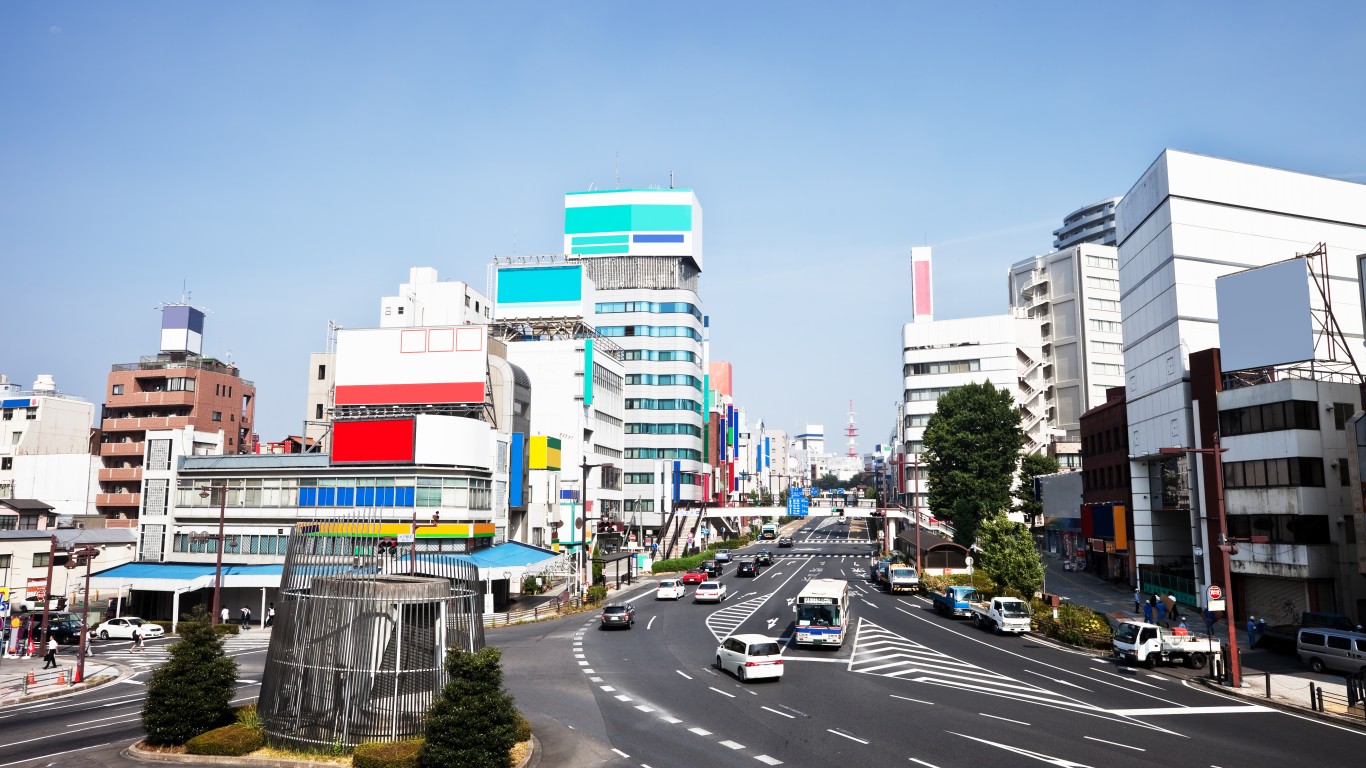
19. Mito, Japan
> Share of city destroyed: 68.9%
> Date of attack: August 1, 1945
> Casualties: N/A
With the war winding down, the city of Mito was attacked on Aug. 1, 1945, and almost 70% of the city was destroyed. Mito was about the size of Pontiac, Michigan. The attack was part of a larger raid involving 830 B-29s.
[in-text-ad-2]
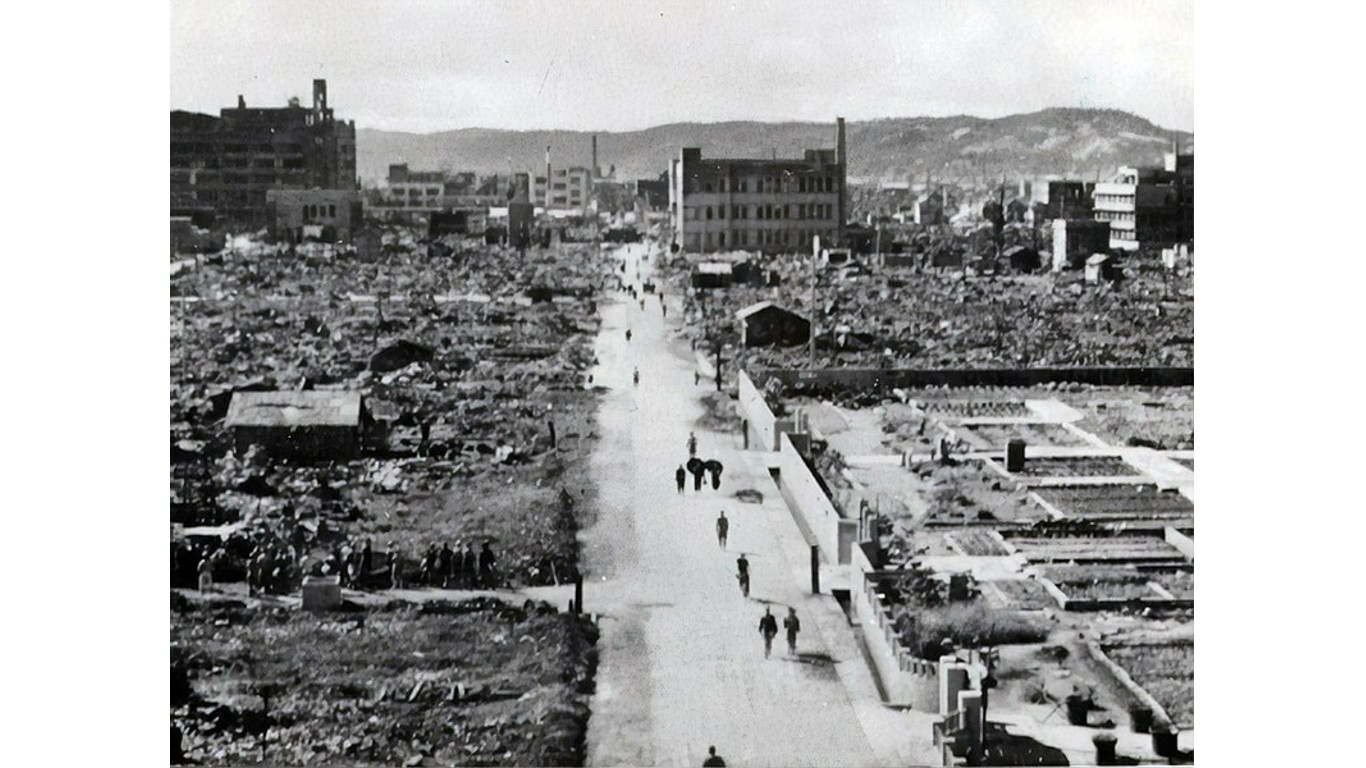
18. Okayama, Japan
> Share of city destroyed: 68.9%
> Date of attack: June 29, 1945
> Casualties: 1,700
Okayama became one of the most important areas in western Japan for transportation and education before WWII. When the war began, an army base camp was established there. The city was attacked on June 29, 1945, by U.S. bombers carrying incendiary bombs that killed 1,700 people and destroyed almost 70% of the city.
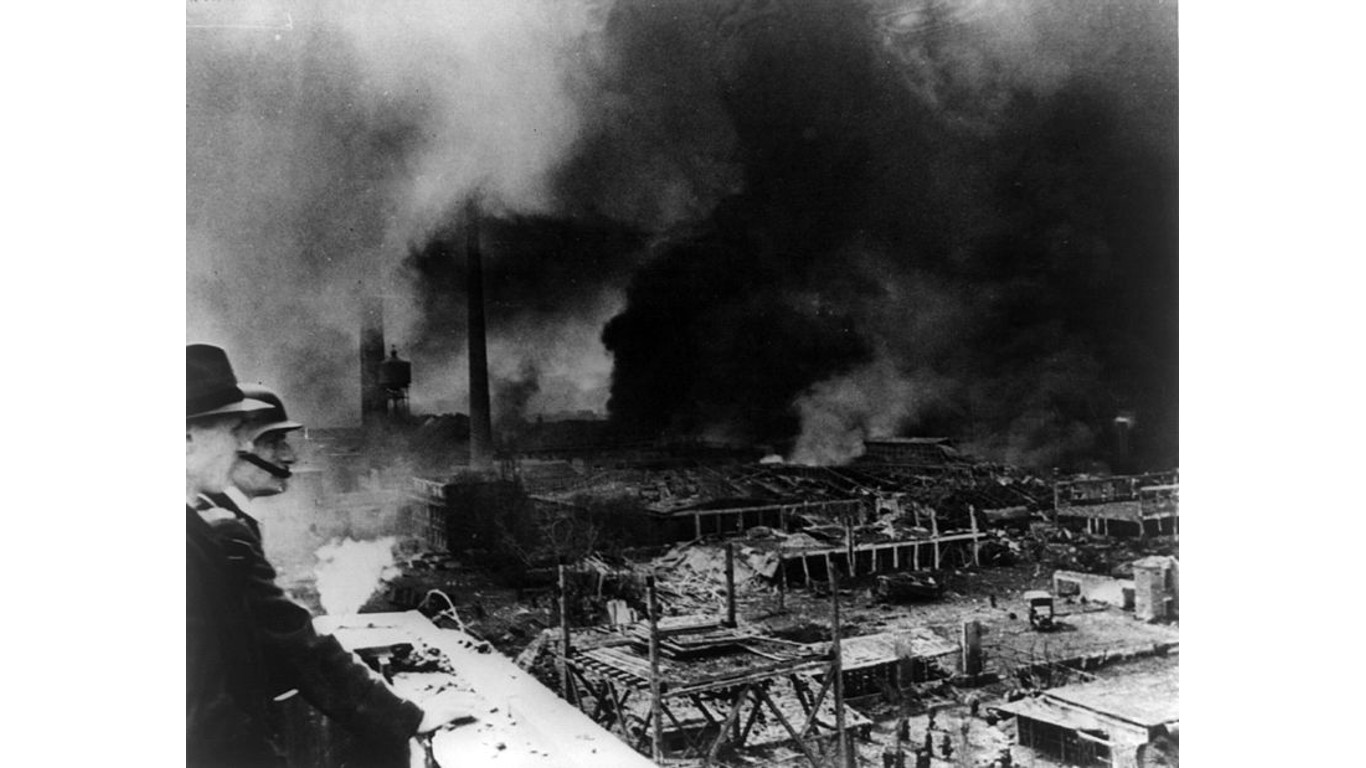
17. Kassel, Germany
> Share of city destroyed: 69.0%
> Date of attack: February 1942 – March 1945
> Casualties: 10,000
The site of aircraft and tank plants and other critical German industrial targets, this city in central/western Germany was bombed more than 20 times during the war. A raid on Oct. 22-23, 1943 resulted in a firestorm. The fire of the most severe air raid burned for seven days, at least 10,000 people died, 150,000 inhabitants were bombed-out, and the vast majority of the city center was destroyed.
[in-text-ad]
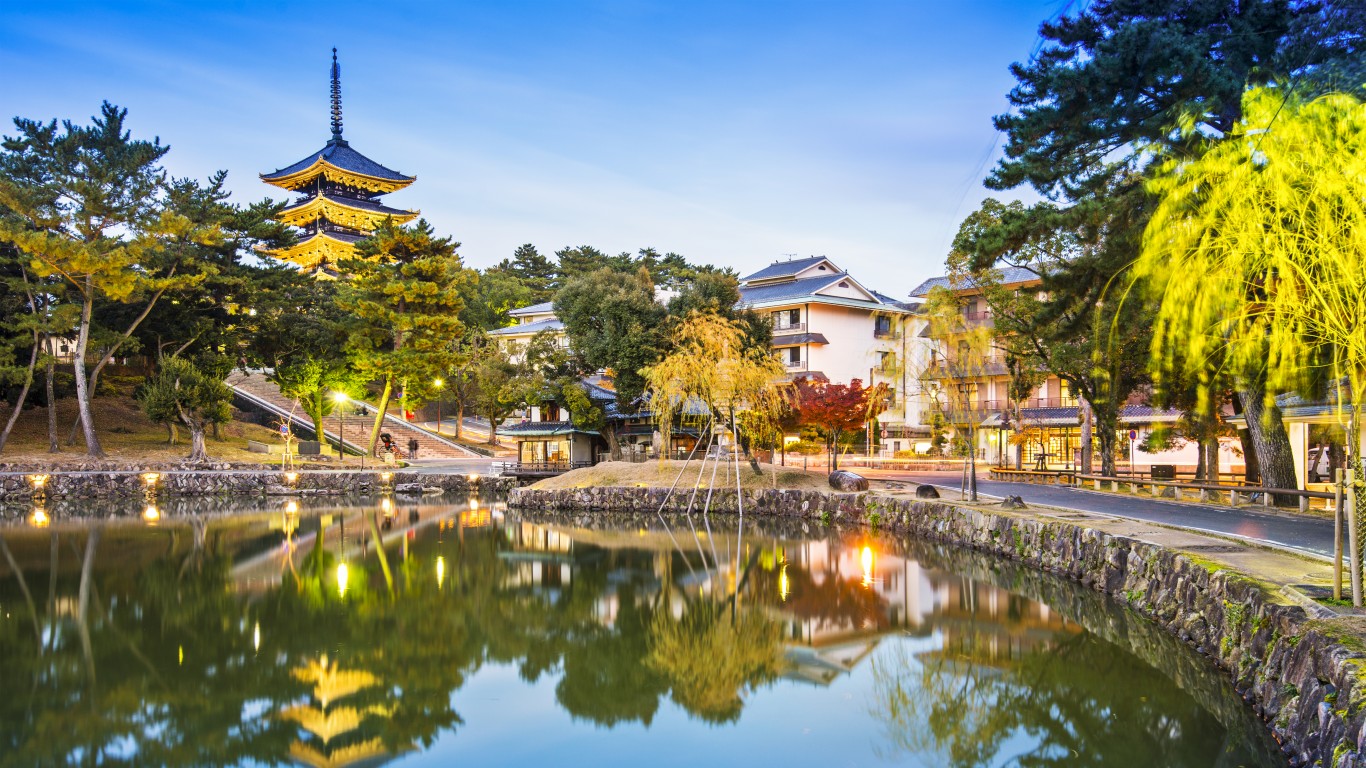
16. Nara, Japan
> Share of city destroyed: 69.3%
> Date of attack: June 9, 1945
> Casualties: N/A
Nara was known for its temples and was a great cultural center in Japan. Almost 70% of the city — about the size of Boston — was destroyed.
15. Tsu, Japan
> Share of city destroyed: 69.3%
> Date of attack: July 28, 1945
> Casualties: N/A
Tsu, about the size of Topeka, Kansas, is on the island of Honshu. Almost 70% damage on July 28, 1945. Tsu was one of six Japanese cities attacked on July 28.
14. Hitachi, Japan
> Share of city destroyed: 72.0%
> Date of attack: July 19, 1945
> Casualties: N/A
Hitachi is on the island of Honshu on the Pacific Coast. The city, about the size of Little Rock, sustained damage of 72%. Besides attacks from the air, Hitachi, an important center for electrical equipment, was attacked by U.S. battleships on July 19. They failed to hit factories but killed civilians.
[in-text-ad-2]
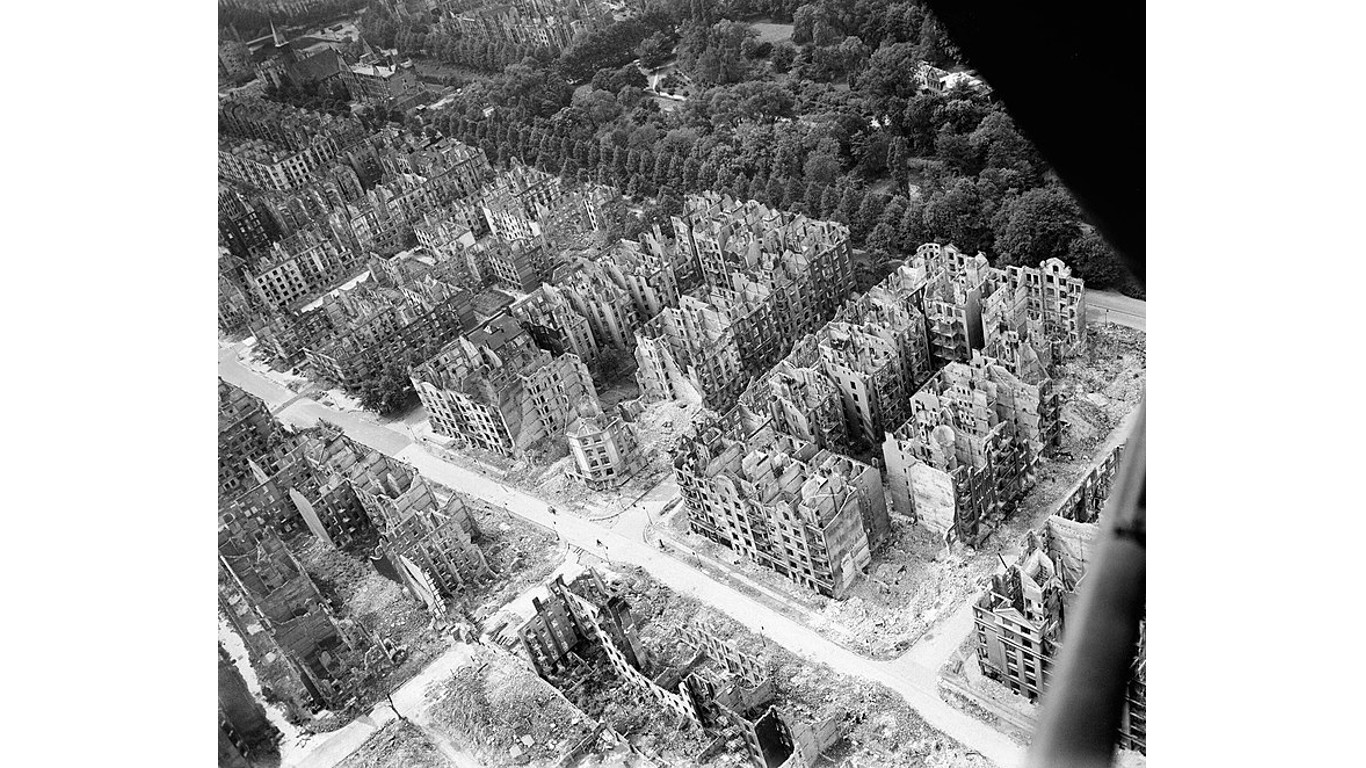
13. Hamburg, Germany
> Share of city destroyed: 75.0%
> Date of attack: July 24-31, 1943
> Casualties: 37,000
Code-named Operation Gomorrah, a week-long combined U.S. and U.K. air attack on this major German industrial city — home to shipyards, oil refineries, and other operations critical to the Nazi war effort — produced one of the largest firestorms of the war, killing about 37,000 and wounding another 180,000 and leaving the city in ruins.
12. Kuwana, Japan
> Share of city destroyed: 75.0%
> Date of attack: July 16, 1945
> Casualties: N/A
Kuwana, in the central part of the island of Honshu, is approximately equivalent in size to Tucson. Kuwana was attacked on July 16, 1945, and 75% of the city was destroyed.
[in-text-ad]

11. Koblenz, Germany
> Share of city destroyed: 80.0%
> Date of attack: November 16, 1944
> Casualties: N/A
Koblenz, on the banks of the Rhine and Moselle rivers, hosted the command of German Army Group B, and as such it was a target of Allied bombing. The city suffered severe aerial bombardment leading to the loss of much of its historic heritage.
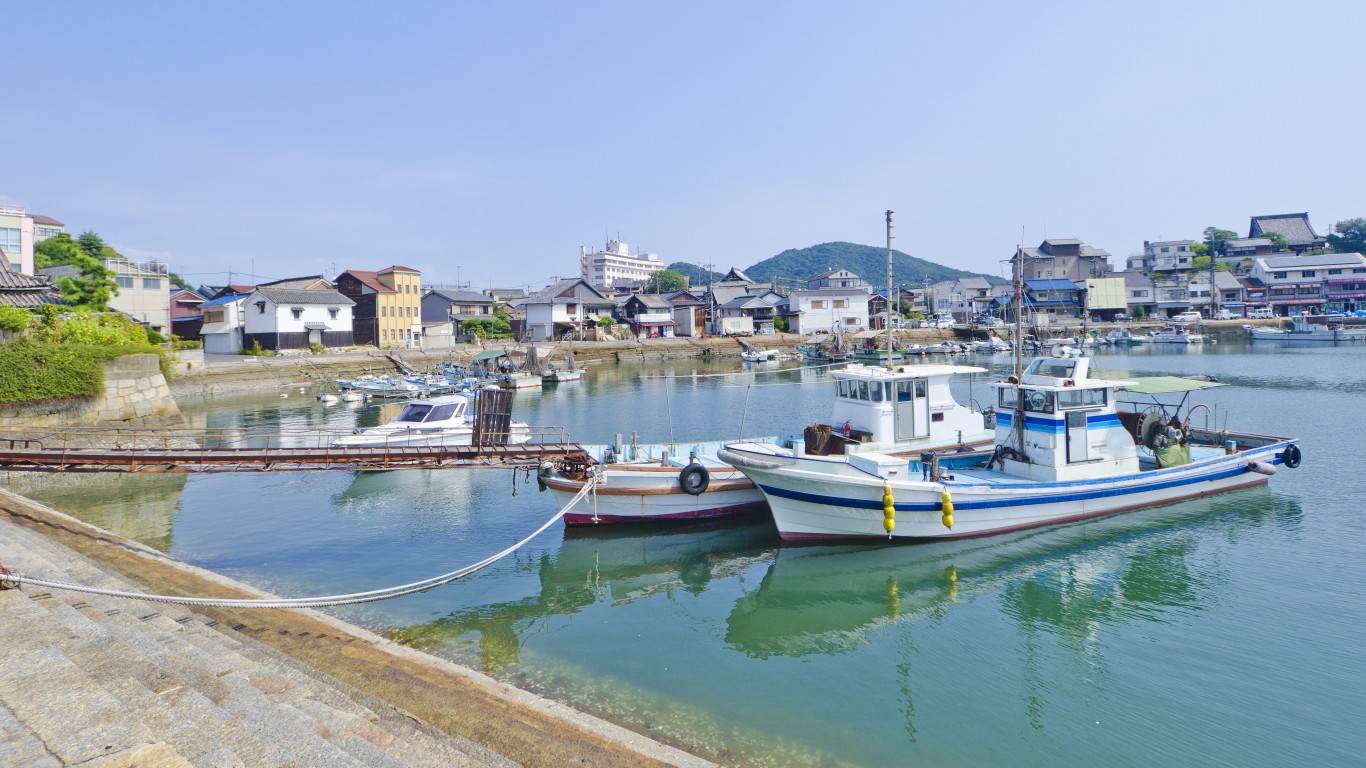
10. Fukuyama, Japan
> Share of city destroyed: 80.9%
> Date of attack: August 8, 1945
> Casualties: N/A
Fukuyama, the largest city in the Hiroshima Prefecture after Hiroshima itself, was known for its 17th-century castle. The city was heavily damaged by Allied bombing two days after the atomic bomb attack on Hiroshima. The attack largely destroyed the castle, but it was restored when the city industrialized after the war.

9. Fukui, Japan
> Share of city destroyed: 84.8%
> Date of attack: July 19, 1945
> Casualties: 1,576
On July 19, 1945, 133 Boeing B-29s launched from Tinian in the Marianas dropped incendiary bombs in a spiral pattern with a radius of almost a mile around the northwest of the city, leaving it in ruins. A firestorm resulted and destroyed most of the city.
[in-text-ad-2]

8. Tokushima, Japan
> Share of city destroyed: 85.2%
> Date of attack: July 3, 1945
> Casualties: 1,000
The bombing of Tokushima, the capital city of Tokushima Prefecture on Shikoku island, began on the eve of the American Independence Day. Incendiary bombs from American B-29s destroyed more than 85% of the city, and 1,000 people were killed.
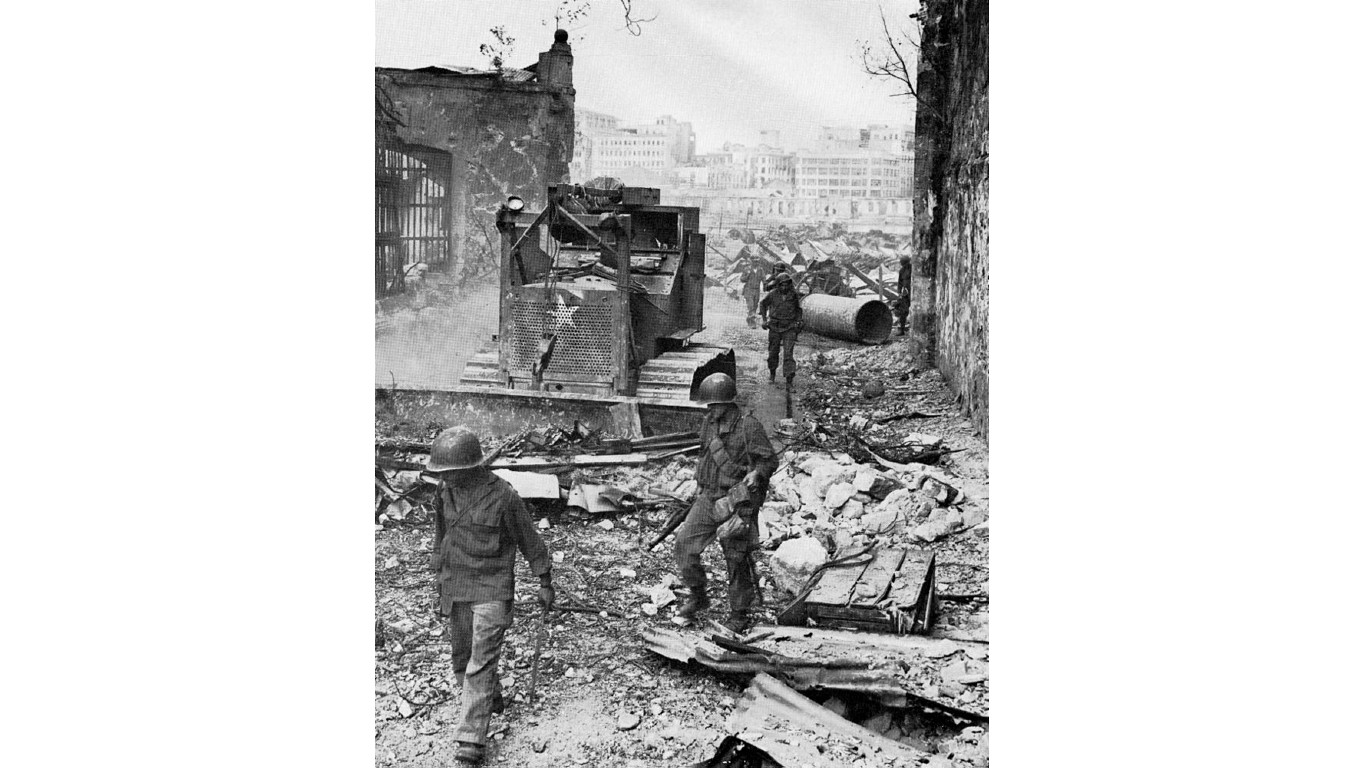
7. Manila, Philippines
> Share of city destroyed: 90.0%
> Date of attack: February 3 – March 3, 1945
> Casualties: 140,000
In a rare instance in WWII of a city destroyed by other than aerial bombing, artillery and cannon fire from tanks destroyed the old city of Manila, the site of extensive urban combat in 1945, as American and Filipino troops expelled the Japanese from the Philippines capital.
[in-text-ad]
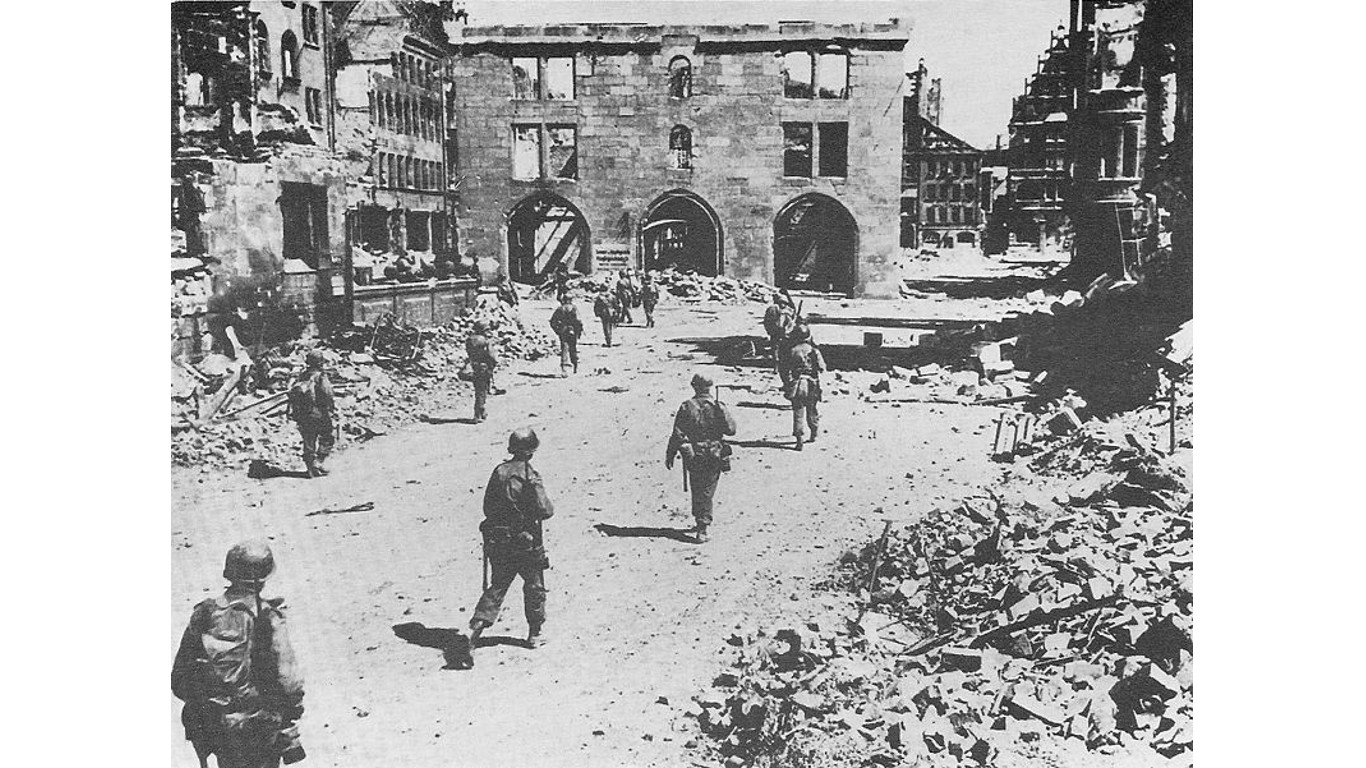
6. Nuremberg, Germany
> Share of city destroyed: 90.0%
> Date of attack: January 2, 1945
> Casualties: 1,800
The bombing of Nuremberg was a series of air raids carried out by allied forces of the Royal Air Force and the United States Army Air Forces that caused heavy damage throughout the city from 1940 through 1945. Nuremberg was a vital economic and infrastructural hub and also held symbolic importance as the seat of Nazism and the site of major Nazi rallies.
5. Saint-Lô, France
> Share of city destroyed: 95.0%
> Date of attack: July 7-19, 1944
> Casualties: 1,000
The French city of Saint-Lô, strategically important as a crossroads, was heavily damaged by American planes during and after the Normandy invasion in 1944 as the Allies tried to enlarge their toehold on the beaches of Normandy. German targets were largely missed and most of the damage and casualties fell on French citizens.
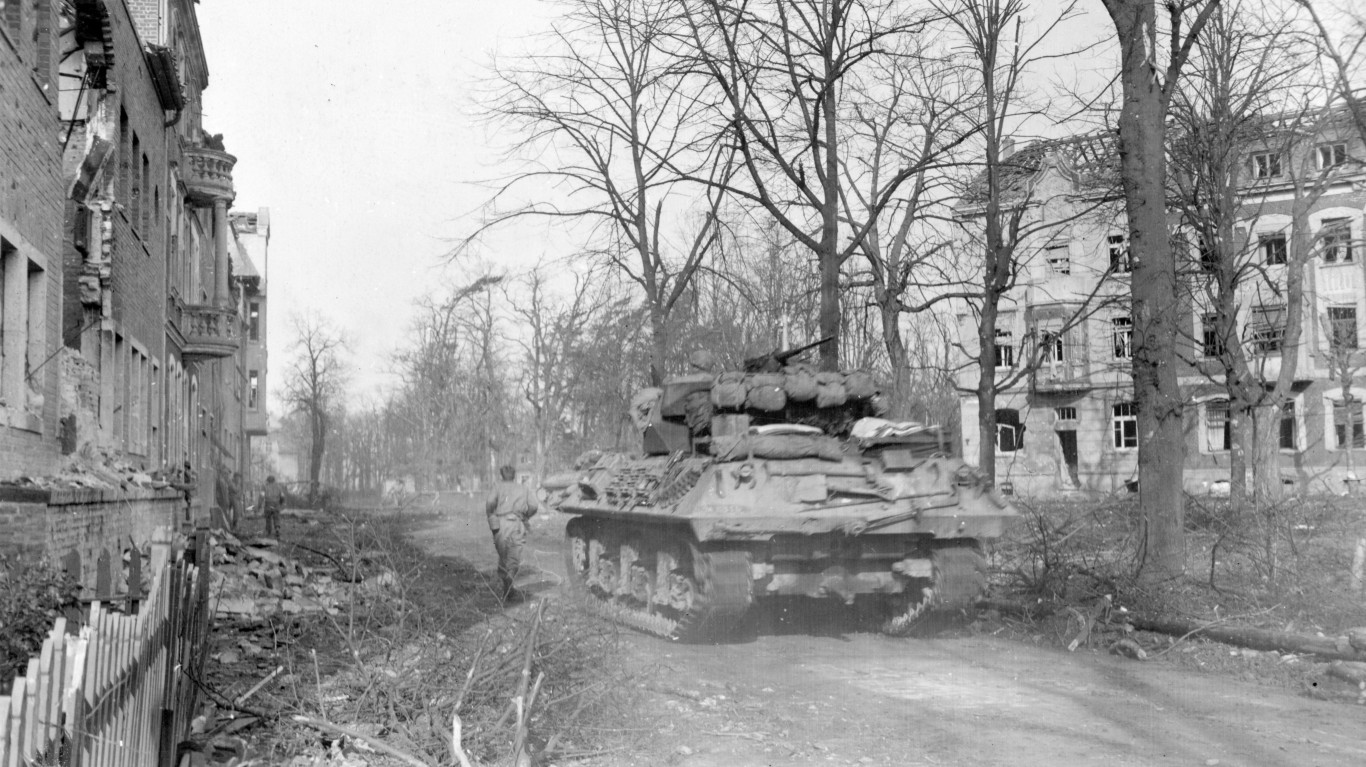
4. Jülich, Germany
> Share of city destroyed: 97.0%
> Date of attack: November 16, 1944
> Casualties: 1,000
The medieval town of Jülich, on a crossing of the River Rur in what is now the state of North Rhine-Westphalia, suffered some of the most intense batterings of the war, with 97% of the town lost to bombing in 1944 and the remaining 3% destroyed after three months of fighting. After the war, the town was rebuilt.
[in-text-ad-2]
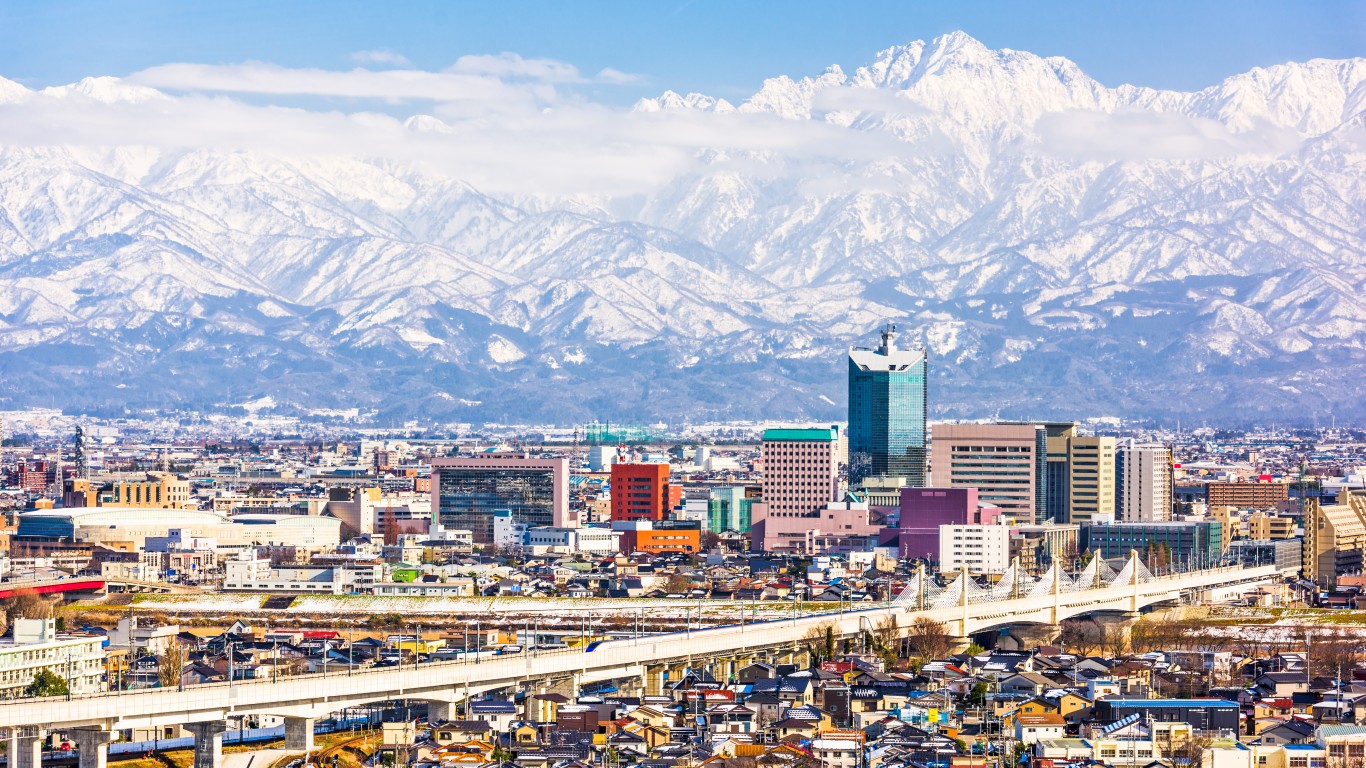
3. Toyama, Japan
> Share of city destroyed: 99.0%
> Date of attack: August 1, 1945
> Casualties: 2,149
Toyama, on the coast of the Sea of Japan in the ChÅ«bu region on central HonshÅ« island, was hit by 173 B-29s on Aug. 1 as part of a larger raid on cities that included HachiÅji, Mito, and Nagaoka. Toyama, a major producer of aluminum, was especially hard hit, with some 99% of its area destroyed.

2. Nagasaki, Japan
> Share of city destroyed: 100.0%
> Date of attack: August 9, 1945
> Casualties: 39,000
Nagasaki, in eastern Japan, and about the size of Akron, Ohio, was the site of the second atomic bomb attack on Aug. 9. It obliterated the city and killed 39,000. The second nuclear attack was a factor in prodding Japan to surrender five days later.
[in-text-ad]
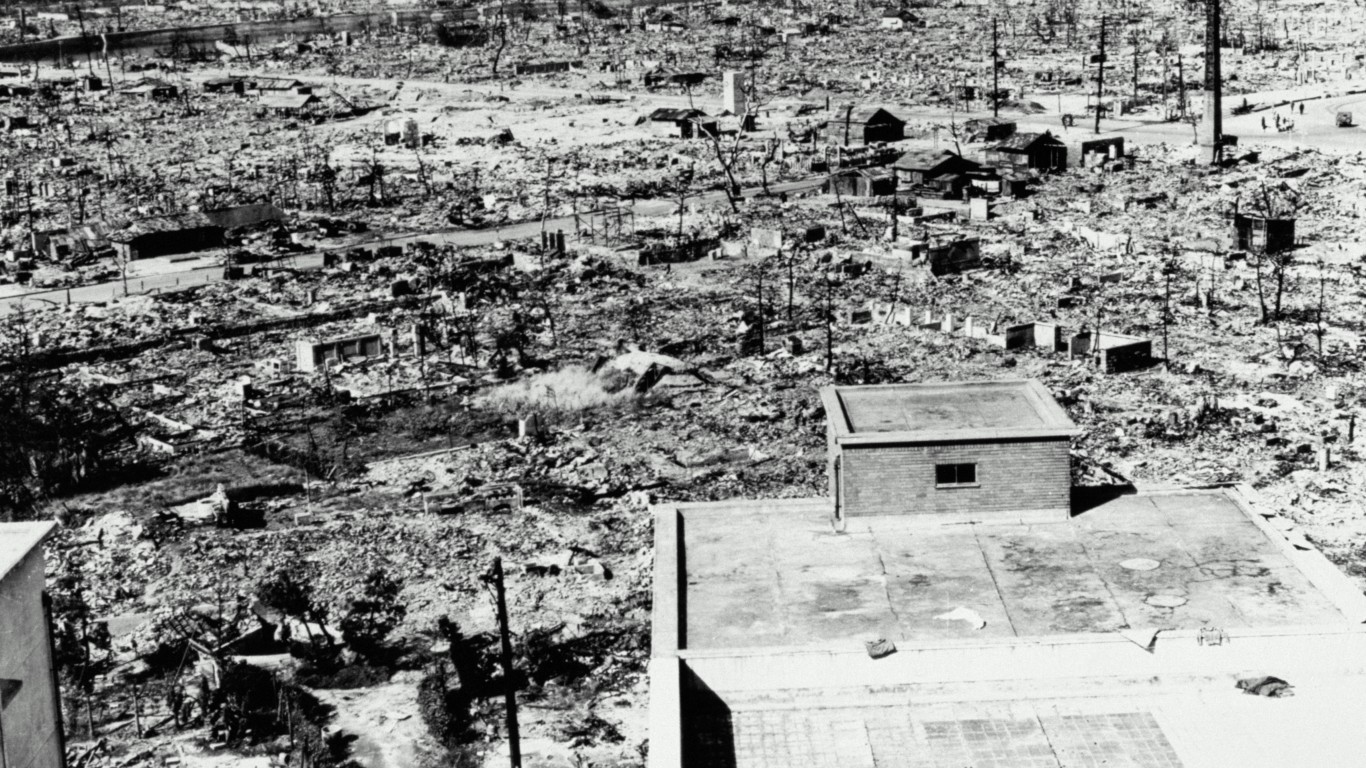
1. Hiroshima, Japan
> Share of city destroyed: 100.0%
> Date of attack: August 6, 1945
> Casualties: 66,000
The world’s first atomic bomb attack occurred in Hiroshima on Aug. 6, 1945, when the city was virtually wiped off the map and 66,000 people perished. The use of atomic weapons began a debate that continues to this day.
It’s Your Money, Your Future—Own It (sponsor)
Are you ahead, or behind on retirement? For families with more than $500,000 saved for retirement, finding a financial advisor who puts your interest first can be the difference, and today it’s easier than ever. SmartAsset’s free tool matches you with up to three fiduciary financial advisors who serve your area in minutes. Each advisor has been carefully vetted and must act in your best interests. Start your search now.
If you’ve saved and built a substantial nest egg for you and your family, don’t delay; get started right here and help your retirement dreams become a retirement reality.
Thank you for reading! Have some feedback for us?
Contact the 24/7 Wall St. editorial team.
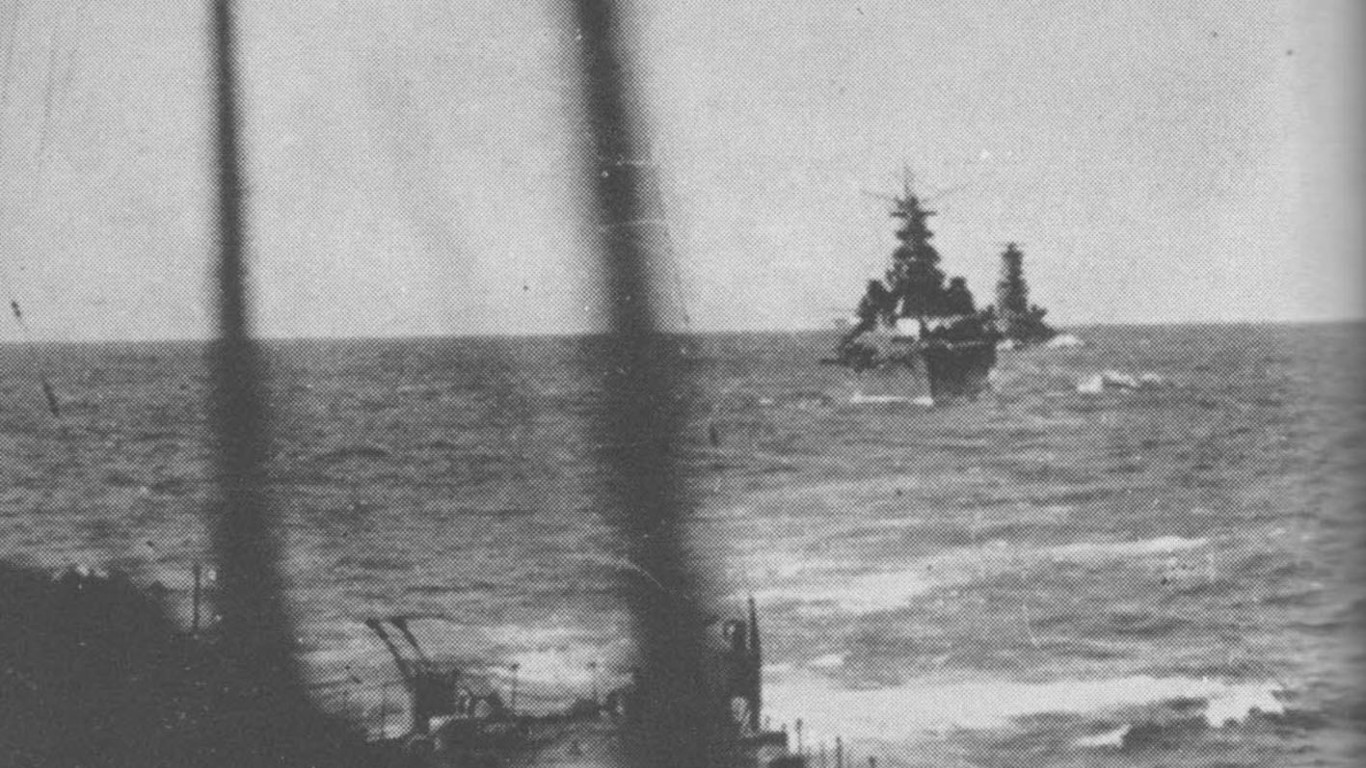 24/7 Wall St.
24/7 Wall St.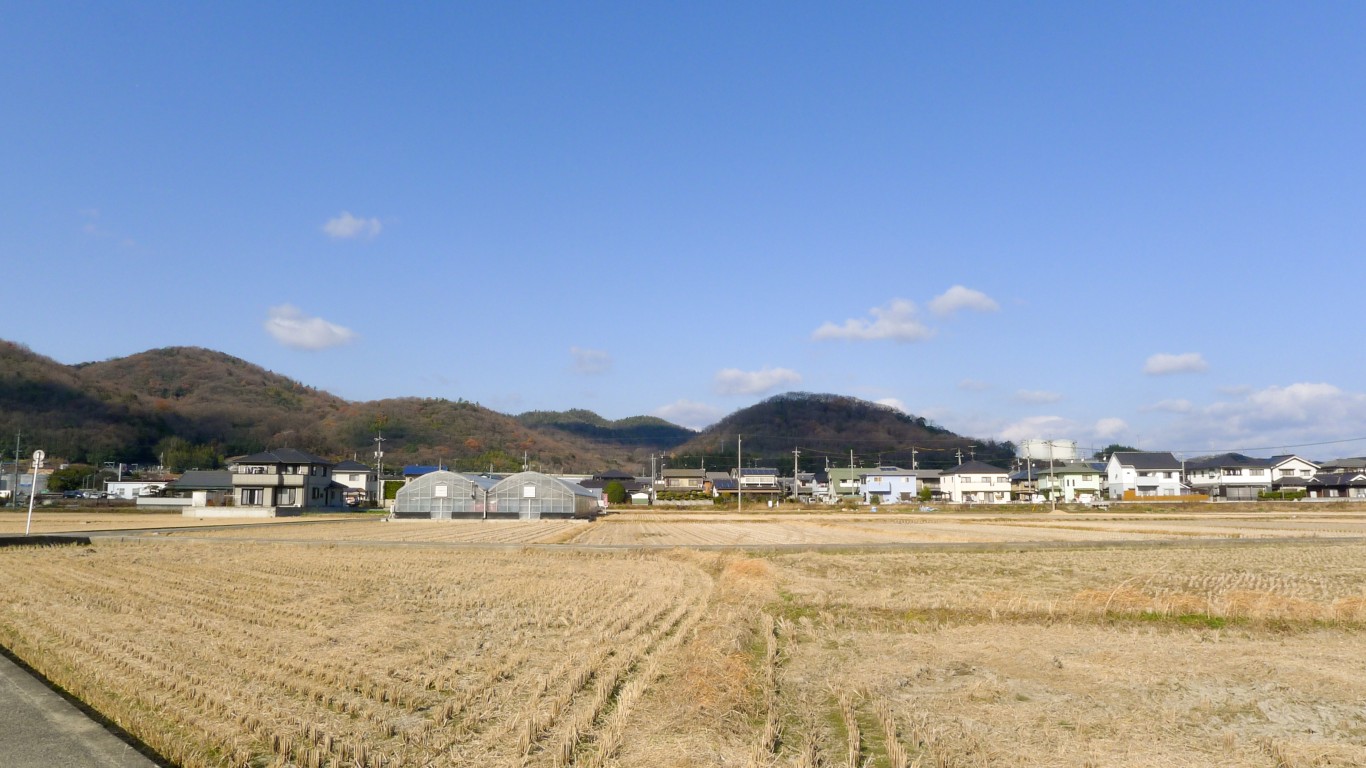
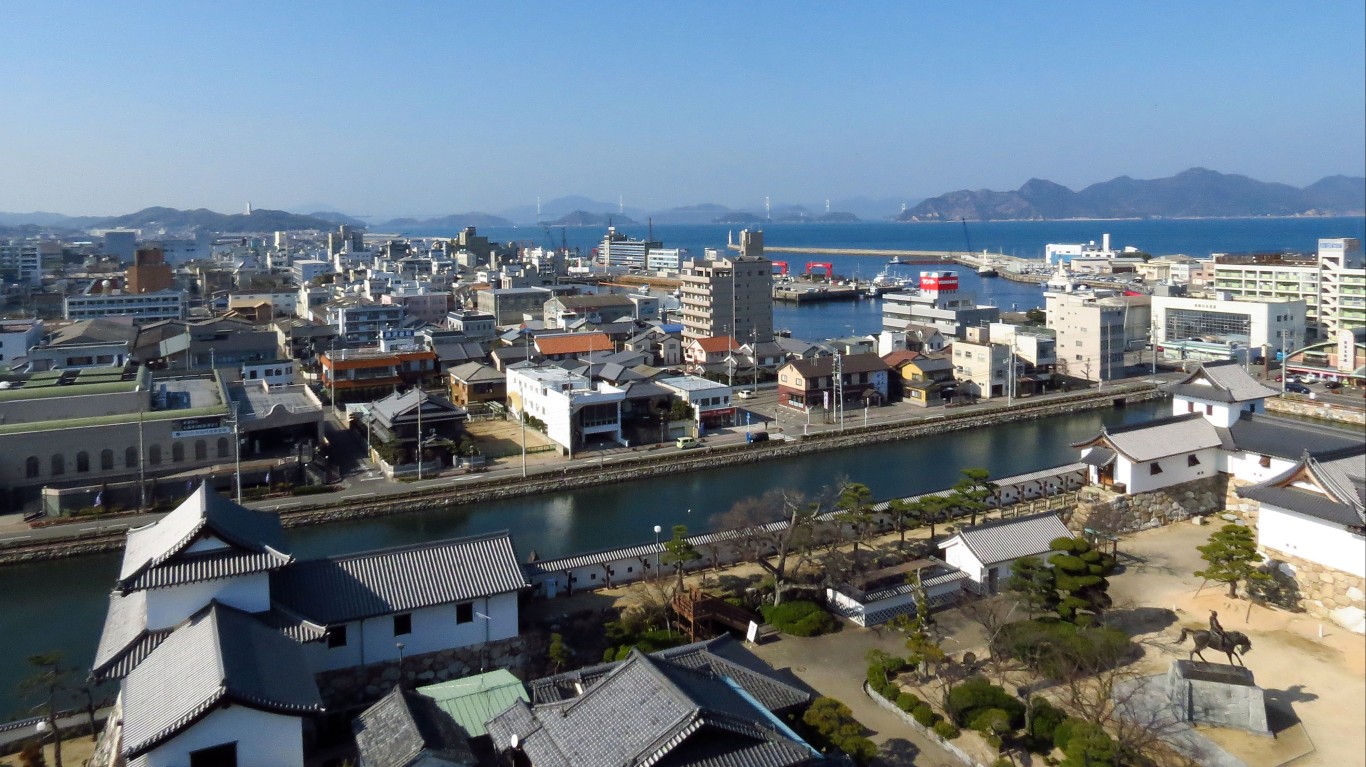
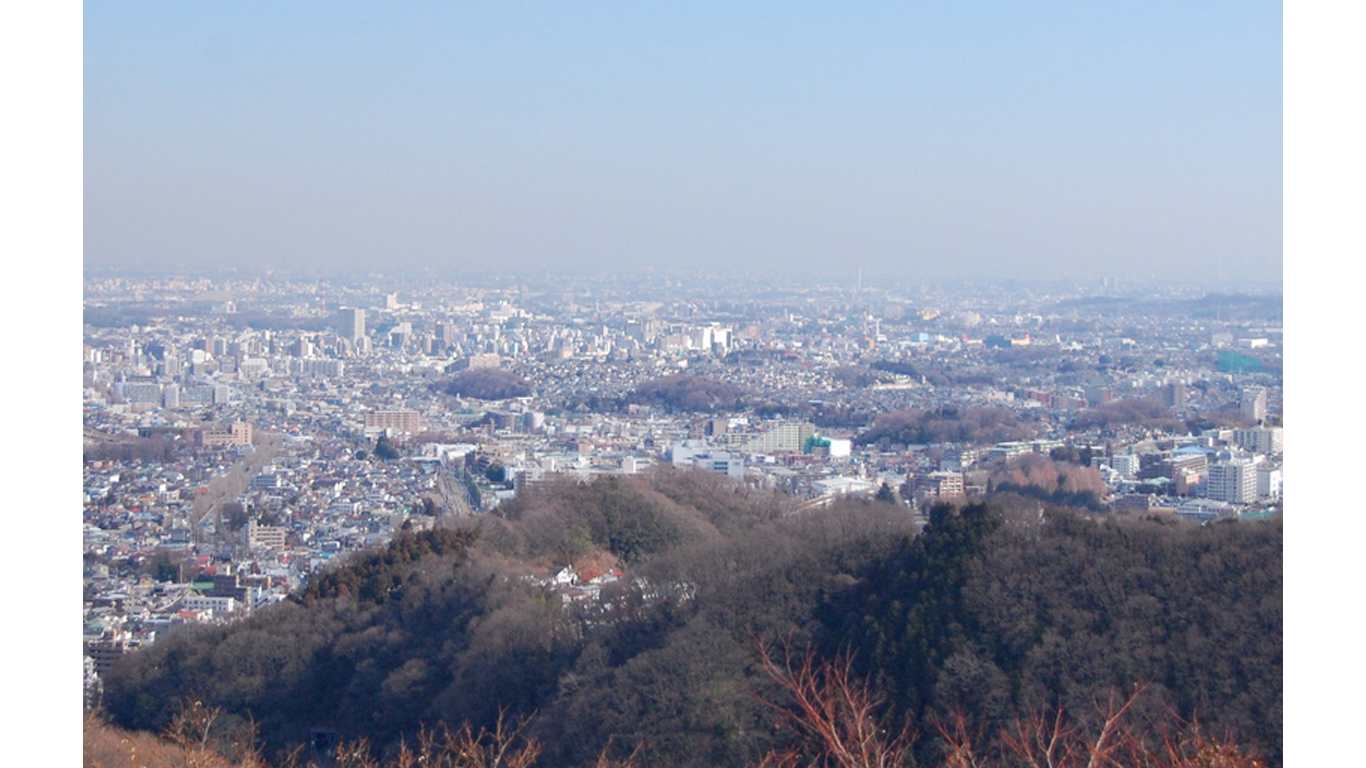
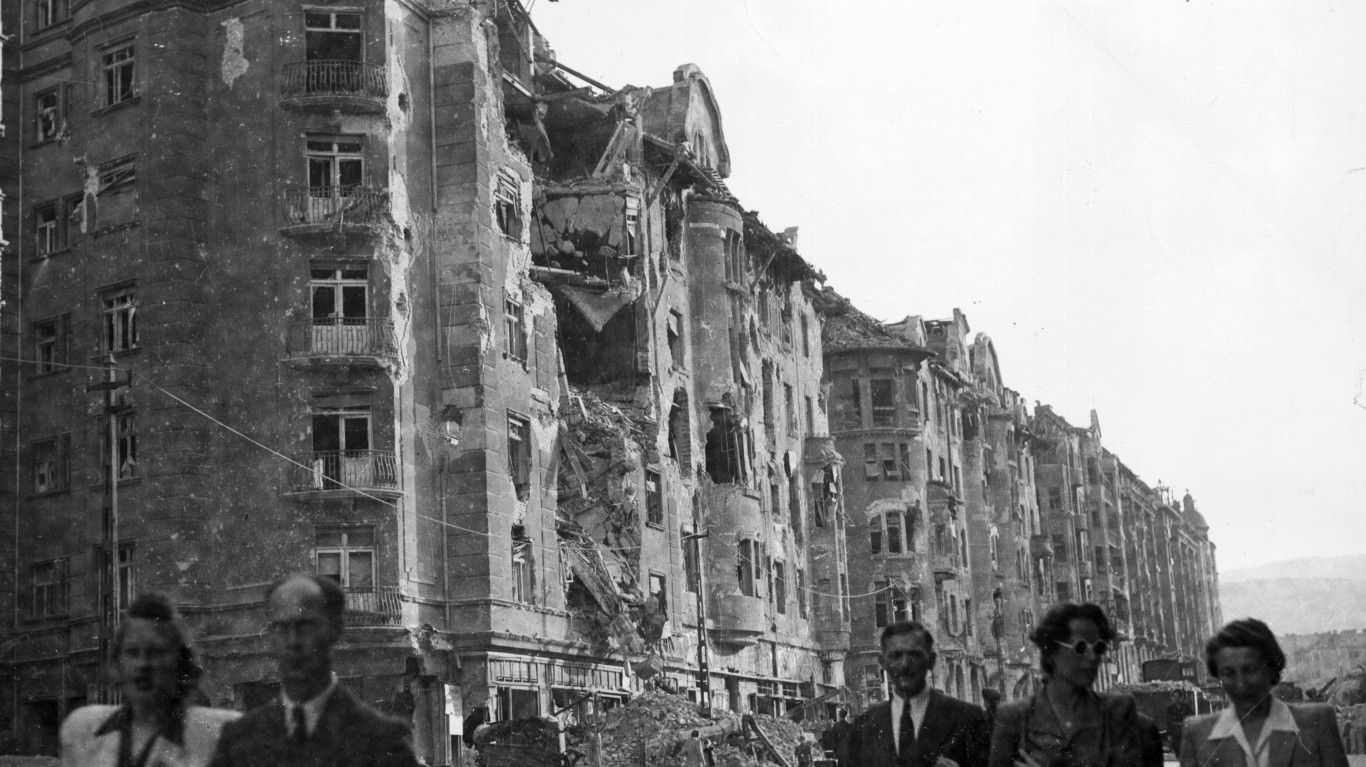 24/7 Wall St.
24/7 Wall St.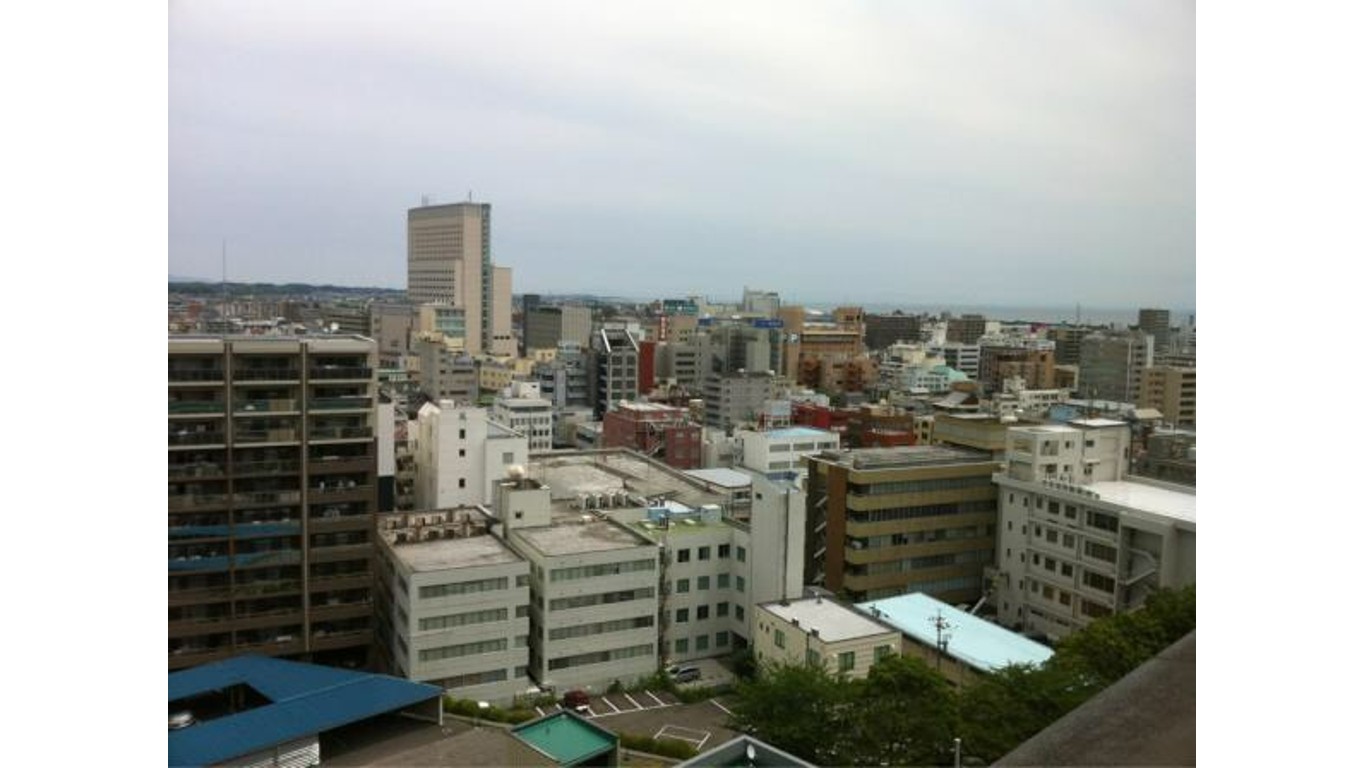
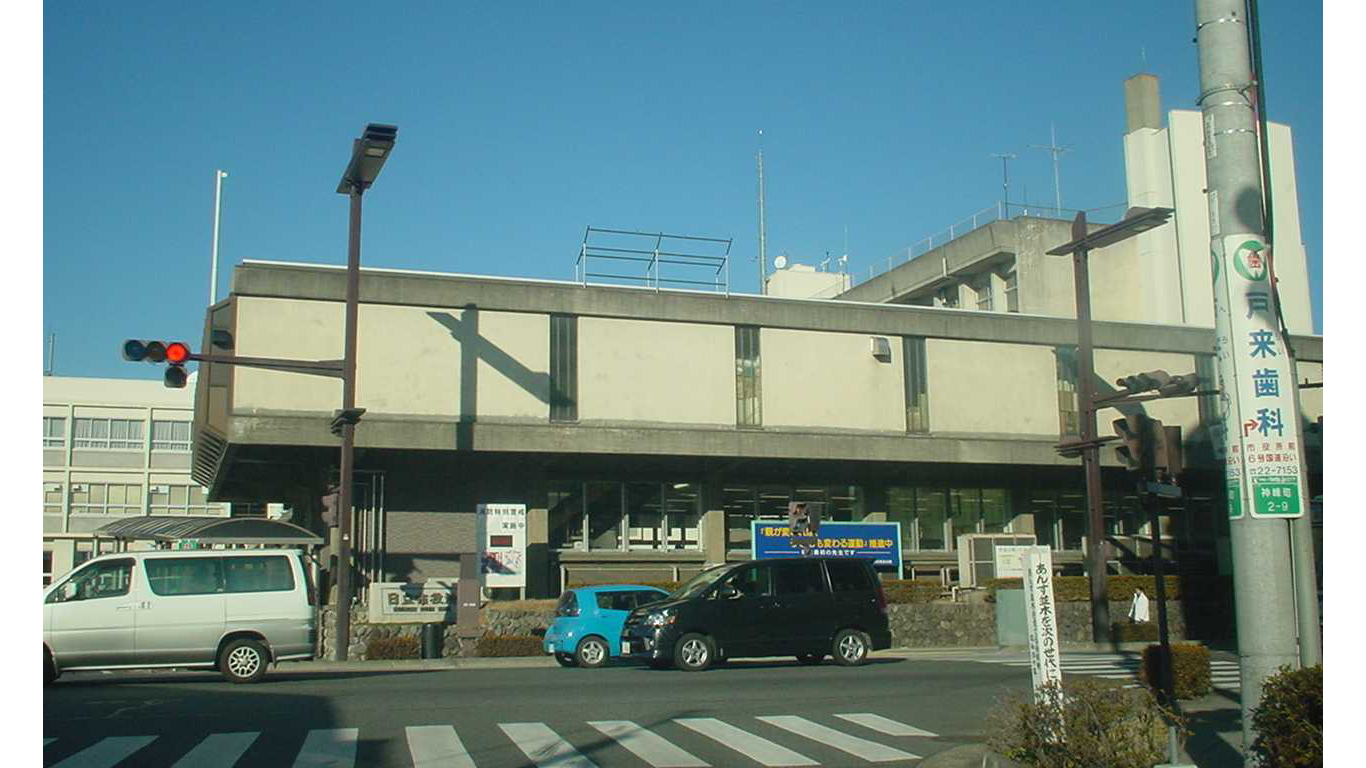
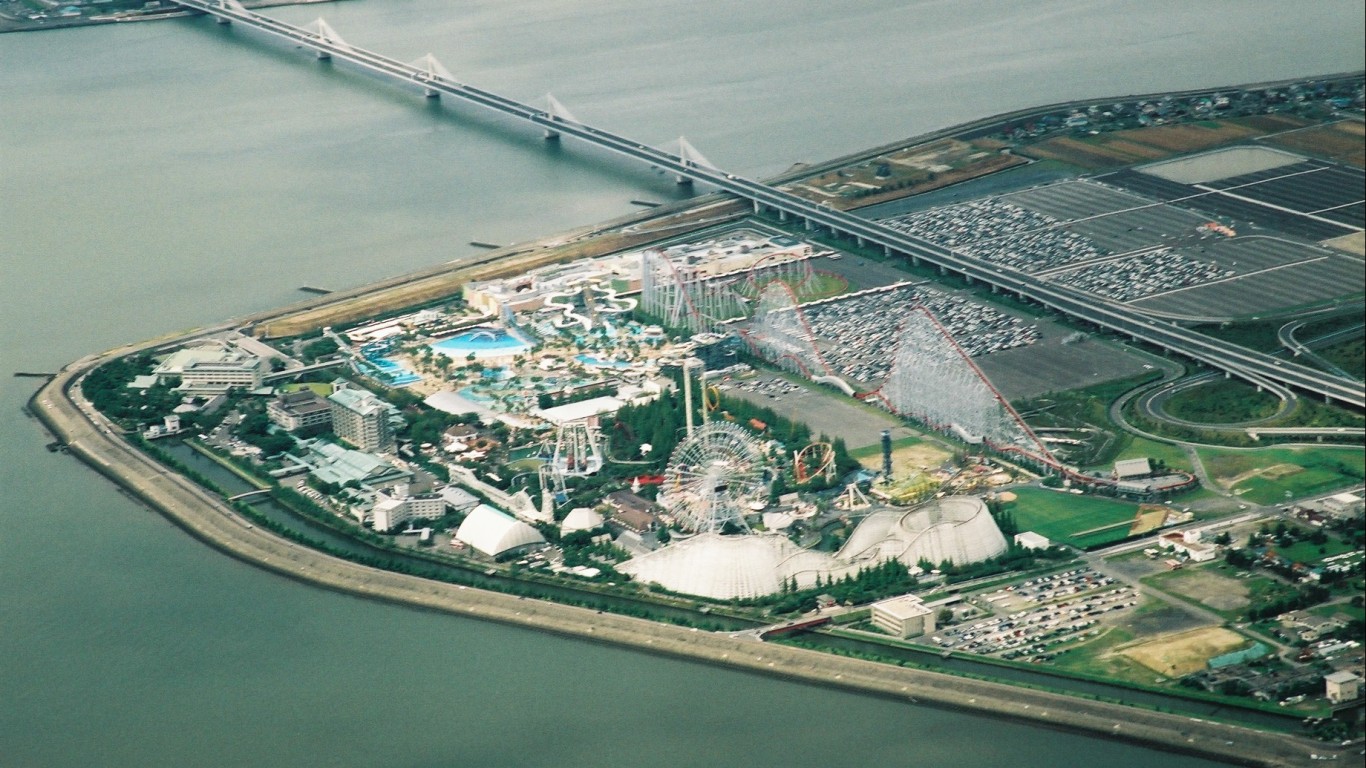
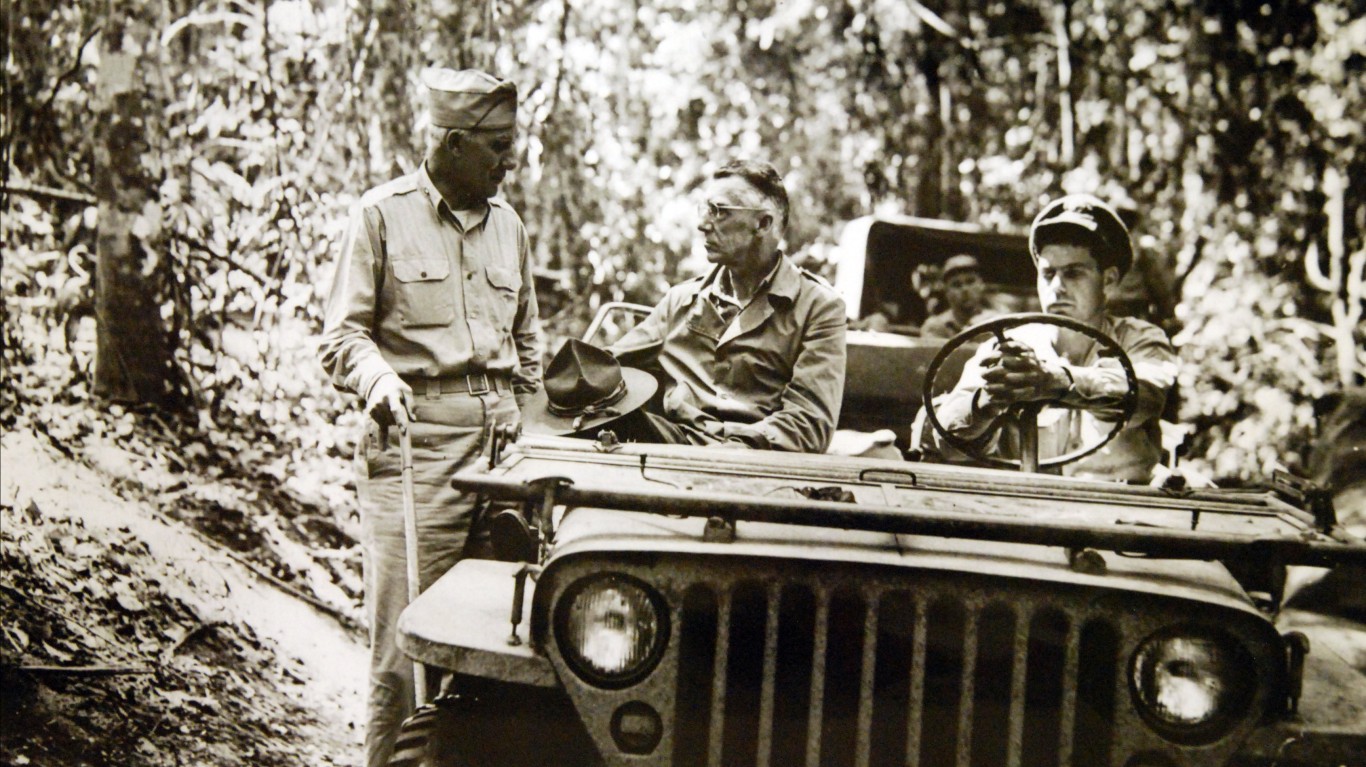 24/7 Wall St.
24/7 Wall St.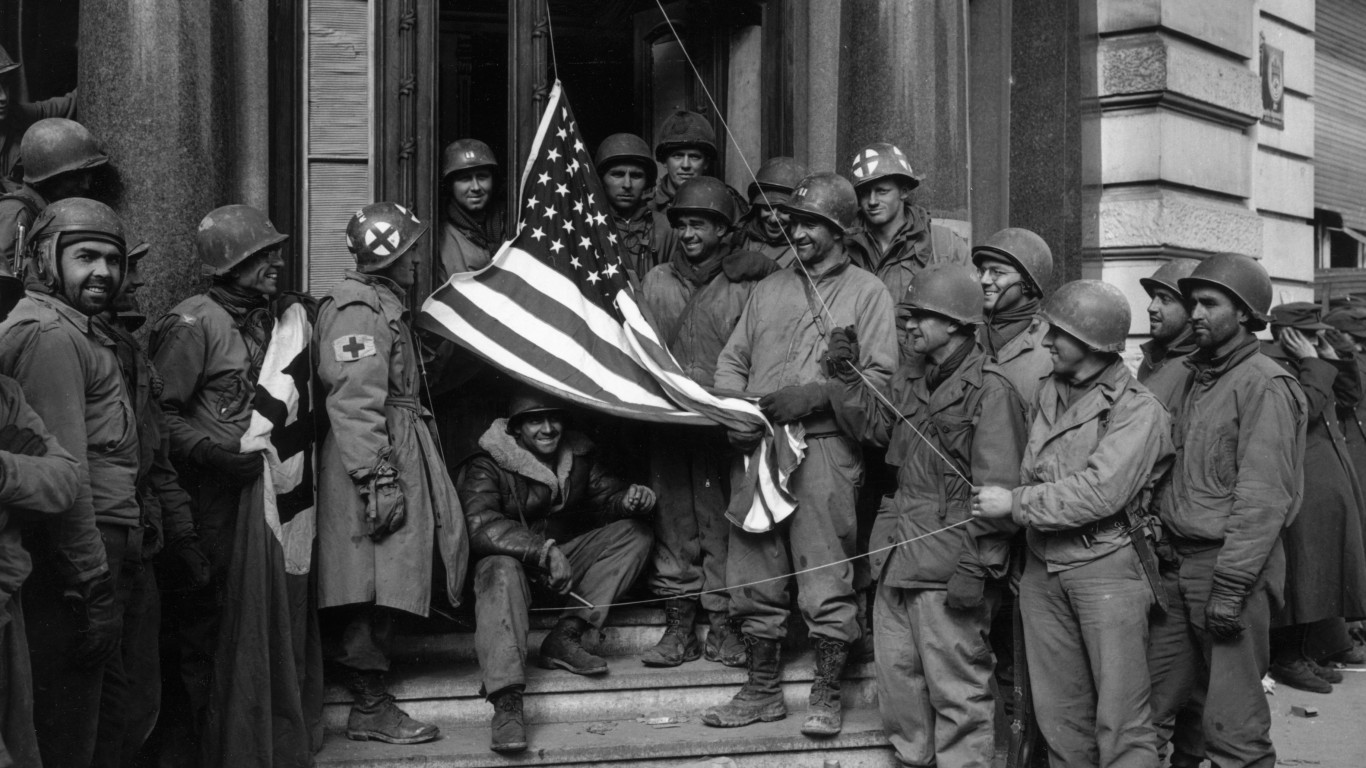 24/7 Wall St.
24/7 Wall St.